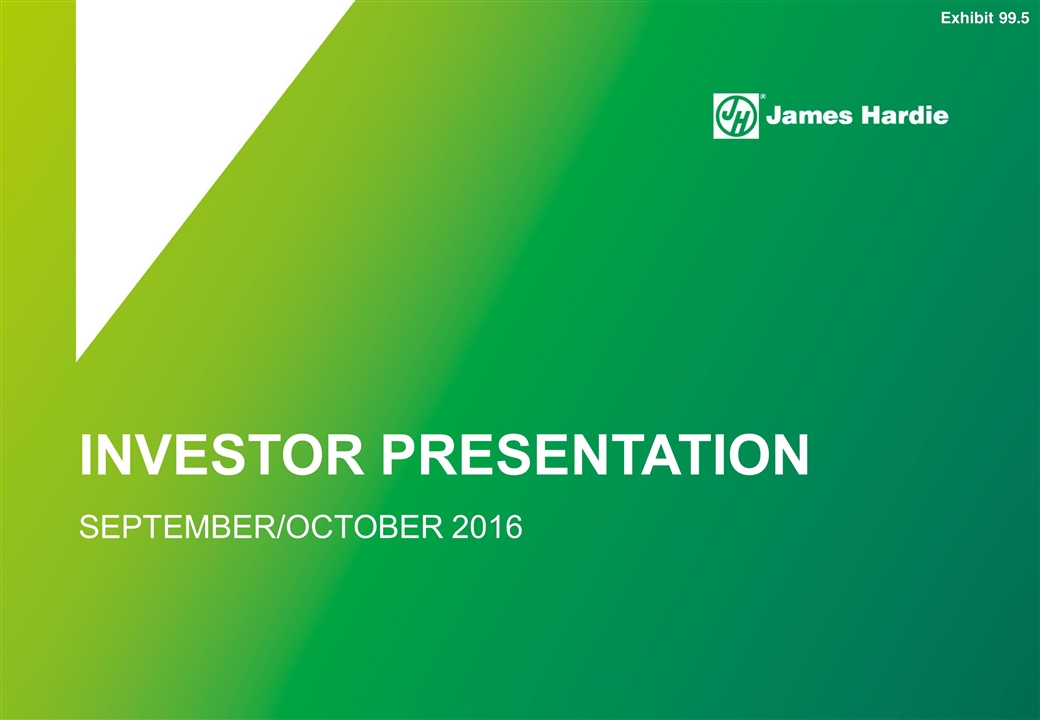

INVESTOR PRESENTATION SEPTEMBER/OCTOBER 2016 Exhibit 99.5

CAUTIONARY NOTE ON FORWARD-LOOKING STATEMENTS This Management Presentation contains forward-looking statements. James Hardie Industries plc (the “company”) may from time to time make forward-looking statements in its periodic reports filed with or furnished to the Securities and Exchange Commission, on Forms 20-F and 6-K, in its annual reports to shareholders, in offering circulars, invitation memoranda and prospectuses, in media releases and other written materials and in oral statements made by the company’s officers, directors or employees to analysts, institutional investors, existing and potential lenders, representatives of the media and others. Statements that are not historical facts are forward-looking statements and such forward-looking statements are statements made pursuant to the Safe Harbor Provisions of the Private Securities Litigation Reform Act of 1995. Examples of forward-looking statements include: statements about the company’s future performance; projections of the company’s results of operations or financial condition; statements regarding the company’s plans, objectives or goals, including those relating to strategies, initiatives, competition, acquisitions, dispositions and/or its products; expectations concerning the costs associated with the suspension or closure of operations at any of the company’s plants and future plans with respect to any such plants; expectations concerning the costs associated with the significant capital expenditure projects at any of the company’s plants and future plans with respect to any such projects; expectations regarding the extension or renewal of the company’s credit facilities including changes to terms, covenants or ratios; expectations concerning dividend payments and share buy-backs; statements concerning the company’s corporate and tax domiciles and structures and potential changes to them, including potential tax charges; statements regarding tax liabilities and related audits, reviews and proceedings; expectations about the timing and amount of contributions to Asbestos Injuries Compensation Fund (AICF), a special purpose fund for the compensation of proven Australian asbestos-related personal injury and death claims; expectations concerning the adequacy of the company’s warranty provisions and estimates for future warranty-related costs; statements regarding the company’s ability to manage legal and regulatory matters (including but not limited to product liability, environmental, intellectual property and competition law matters) and to resolve any such pending legal and regulatory matters within current estimates and in anticipation of certain third-party recoveries; and statements about economic conditions, such as changes in the US economic or housing recovery or changes in the market conditions in the Asia Pacific region, the levels of new home construction and home renovations, unemployment levels, changes in consumer income, changes or stability in housing values, the availability of mortgages and other financing, mortgage and other interest rates, housing affordability and supply, the levels of foreclosures and home resales, currency exchange rates, and builder and consumer confidence.
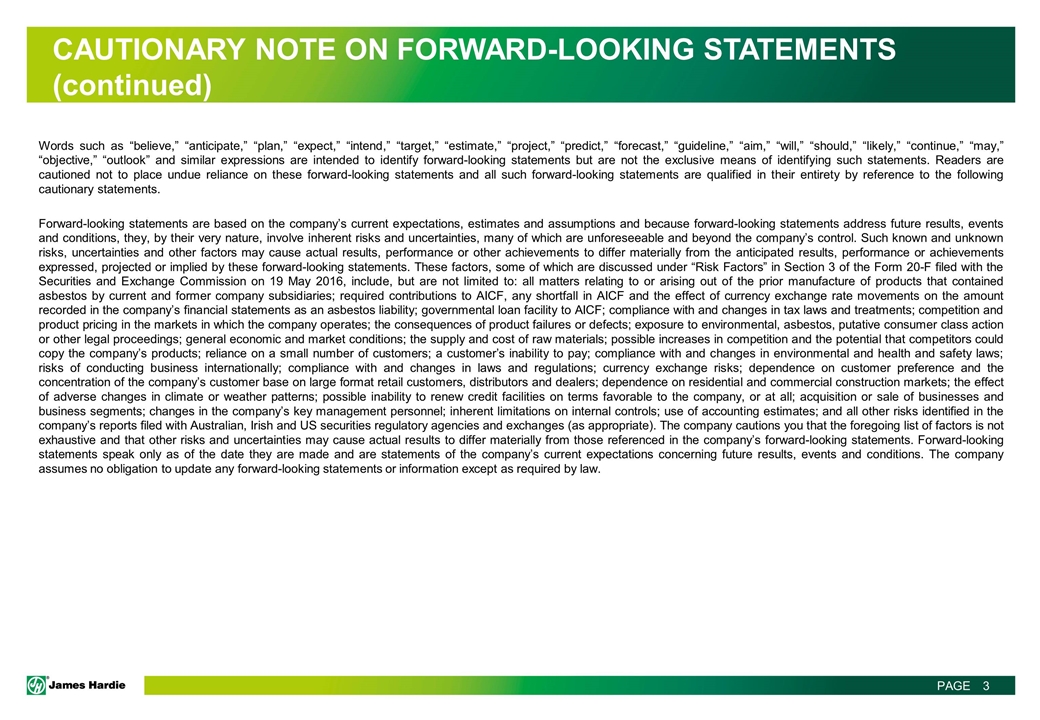
CAUTIONARY NOTE ON FORWARD-LOOKING STATEMENTS (continued) Words such as “believe,” “anticipate,” “plan,” “expect,” “intend,” “target,” “estimate,” “project,” “predict,” “forecast,” “guideline,” “aim,” “will,” “should,” “likely,” “continue,” “may,” “objective,” “outlook” and similar expressions are intended to identify forward-looking statements but are not the exclusive means of identifying such statements. Readers are cautioned not to place undue reliance on these forward-looking statements and all such forward-looking statements are qualified in their entirety by reference to the following cautionary statements. Forward-looking statements are based on the company’s current expectations, estimates and assumptions and because forward-looking statements address future results, events and conditions, they, by their very nature, involve inherent risks and uncertainties, many of which are unforeseeable and beyond the company’s control. Such known and unknown risks, uncertainties and other factors may cause actual results, performance or other achievements to differ materially from the anticipated results, performance or achievements expressed, projected or implied by these forward-looking statements. These factors, some of which are discussed under “Risk Factors” in Section 3 of the Form 20-F filed with the Securities and Exchange Commission on 19 May 2016, include, but are not limited to: all matters relating to or arising out of the prior manufacture of products that contained asbestos by current and former company subsidiaries; required contributions to AICF, any shortfall in AICF and the effect of currency exchange rate movements on the amount recorded in the company’s financial statements as an asbestos liability; governmental loan facility to AICF; compliance with and changes in tax laws and treatments; competition and product pricing in the markets in which the company operates; the consequences of product failures or defects; exposure to environmental, asbestos, putative consumer class action or other legal proceedings; general economic and market conditions; the supply and cost of raw materials; possible increases in competition and the potential that competitors could copy the company’s products; reliance on a small number of customers; a customer’s inability to pay; compliance with and changes in environmental and health and safety laws; risks of conducting business internationally; compliance with and changes in laws and regulations; currency exchange risks; dependence on customer preference and the concentration of the company’s customer base on large format retail customers, distributors and dealers; dependence on residential and commercial construction markets; the effect of adverse changes in climate or weather patterns; possible inability to renew credit facilities on terms favorable to the company, or at all; acquisition or sale of businesses and business segments; changes in the company’s key management personnel; inherent limitations on internal controls; use of accounting estimates; and all other risks identified in the company’s reports filed with Australian, Irish and US securities regulatory agencies and exchanges (as appropriate). The company cautions you that the foregoing list of factors is not exhaustive and that other risks and uncertainties may cause actual results to differ materially from those referenced in the company’s forward-looking statements. Forward-looking statements speak only as of the date they are made and are statements of the company’s current expectations concerning future results, events and conditions. The company assumes no obligation to update any forward-looking statements or information except as required by law.
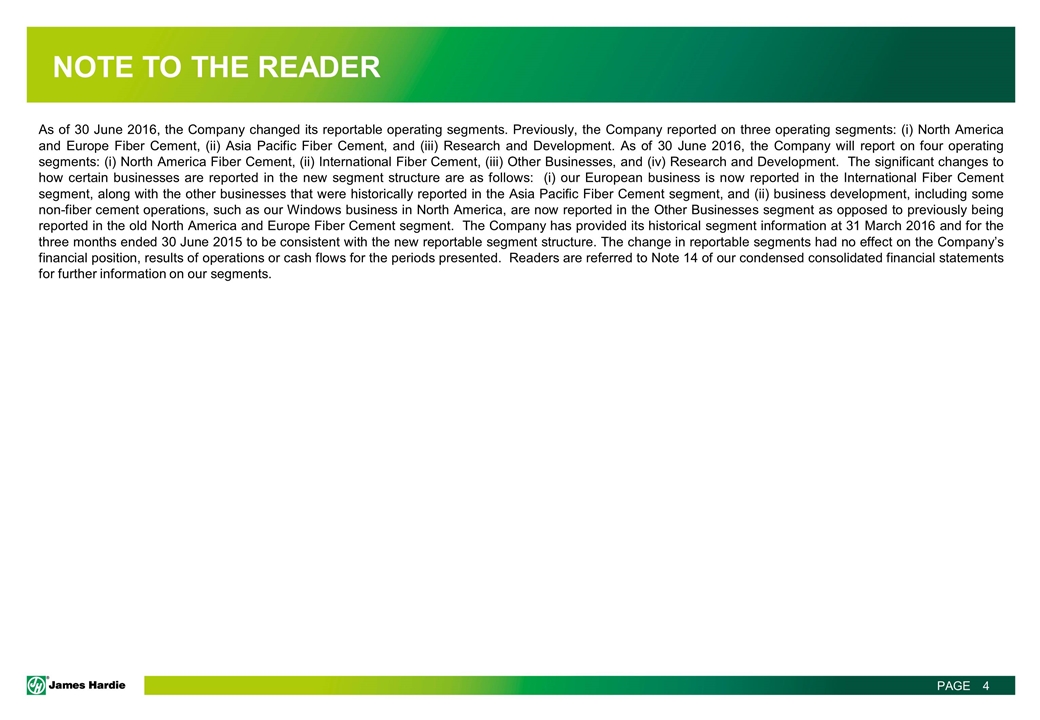
NOTE TO THE READER As of 30 June 2016, the Company changed its reportable operating segments. Previously, the Company reported on three operating segments: (i) North America and Europe Fiber Cement, (ii) Asia Pacific Fiber Cement, and (iii) Research and Development. As of 30 June 2016, the Company will report on four operating segments: (i) North America Fiber Cement, (ii) International Fiber Cement, (iii) Other Businesses, and (iv) Research and Development. The significant changes to how certain businesses are reported in the new segment structure are as follows: (i) our European business is now reported in the International Fiber Cement segment, along with the other businesses that were historically reported in the Asia Pacific Fiber Cement segment, and (ii) business development, including some non-fiber cement operations, such as our Windows business in North America, are now reported in the Other Businesses segment as opposed to previously being reported in the old North America and Europe Fiber Cement segment. The Company has provided its historical segment information at 31 March 2016 and for the three months ended 30 June 2015 to be consistent with the new reportable segment structure. The change in reportable segments had no effect on the Company’s financial position, results of operations or cash flows for the periods presented. Readers are referred to Note 14 of our condensed consolidated financial statements for further information on our segments.
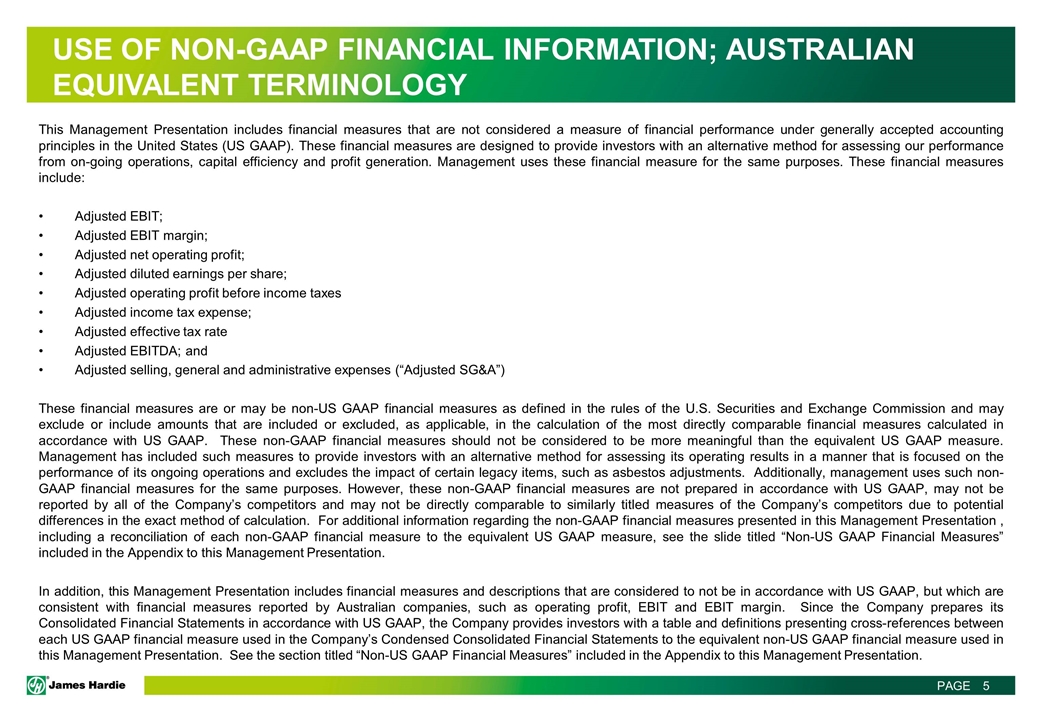
USE OF NON-GAAP FINANCIAL INFORMATION; AUSTRALIAN EQUIVALENT TERMINOLOGY This Management Presentation includes financial measures that are not considered a measure of financial performance under generally accepted accounting principles in the United States (US GAAP). These financial measures are designed to provide investors with an alternative method for assessing our performance from on-going operations, capital efficiency and profit generation. Management uses these financial measure for the same purposes. These financial measures include: Adjusted EBIT; Adjusted EBIT margin; Adjusted net operating profit; Adjusted diluted earnings per share; Adjusted operating profit before income taxes Adjusted income tax expense; Adjusted effective tax rate Adjusted EBITDA; and Adjusted selling, general and administrative expenses (“Adjusted SG&A”) These financial measures are or may be non-US GAAP financial measures as defined in the rules of the U.S. Securities and Exchange Commission and may exclude or include amounts that are included or excluded, as applicable, in the calculation of the most directly comparable financial measures calculated in accordance with US GAAP. These non-GAAP financial measures should not be considered to be more meaningful than the equivalent US GAAP measure. Management has included such measures to provide investors with an alternative method for assessing its operating results in a manner that is focused on the performance of its ongoing operations and excludes the impact of certain legacy items, such as asbestos adjustments. Additionally, management uses such non-GAAP financial measures for the same purposes. However, these non-GAAP financial measures are not prepared in accordance with US GAAP, may not be reported by all of the Company’s competitors and may not be directly comparable to similarly titled measures of the Company’s competitors due to potential differences in the exact method of calculation. For additional information regarding the non-GAAP financial measures presented in this Management Presentation , including a reconciliation of each non-GAAP financial measure to the equivalent US GAAP measure, see the slide titled “Non-US GAAP Financial Measures” included in the Appendix to this Management Presentation. In addition, this Management Presentation includes financial measures and descriptions that are considered to not be in accordance with US GAAP, but which are consistent with financial measures reported by Australian companies, such as operating profit, EBIT and EBIT margin. Since the Company prepares its Consolidated Financial Statements in accordance with US GAAP, the Company provides investors with a table and definitions presenting cross-references between each US GAAP financial measure used in the Company’s Condensed Consolidated Financial Statements to the equivalent non-US GAAP financial measure used in this Management Presentation. See the section titled “Non-US GAAP Financial Measures” included in the Appendix to this Management Presentation.
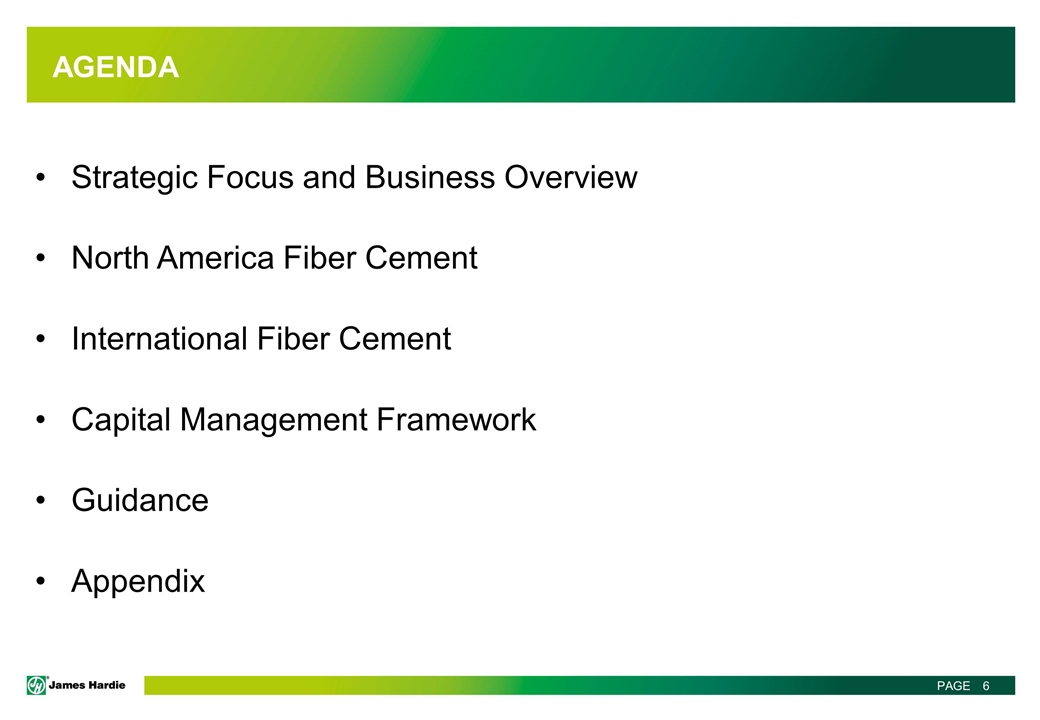
AGENDA Strategic Focus and Business Overview North America Fiber Cement International Fiber Cement Capital Management Framework Guidance Appendix
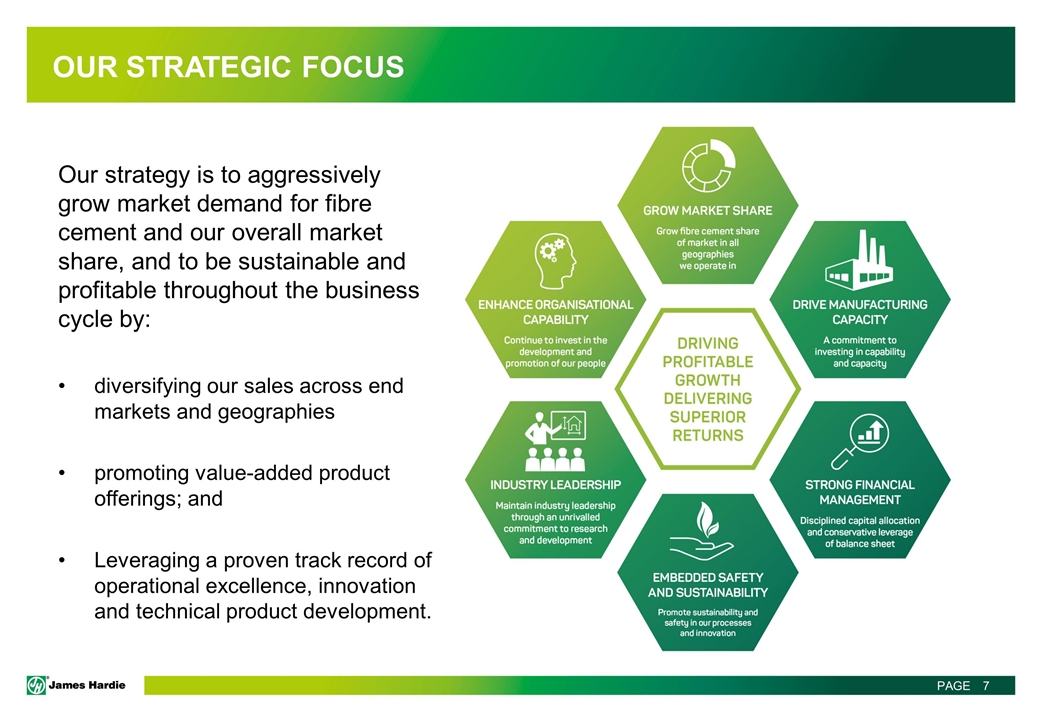
OUR STRATEGIC FOCUS Our strategy is to aggressively grow market demand for fibre cement and our overall market share, and to be sustainable and profitable throughout the business cycle by: diversifying our sales across end markets and geographies promoting value-added product offerings; and Leveraging a proven track record of operational excellence, innovation and technical product development.
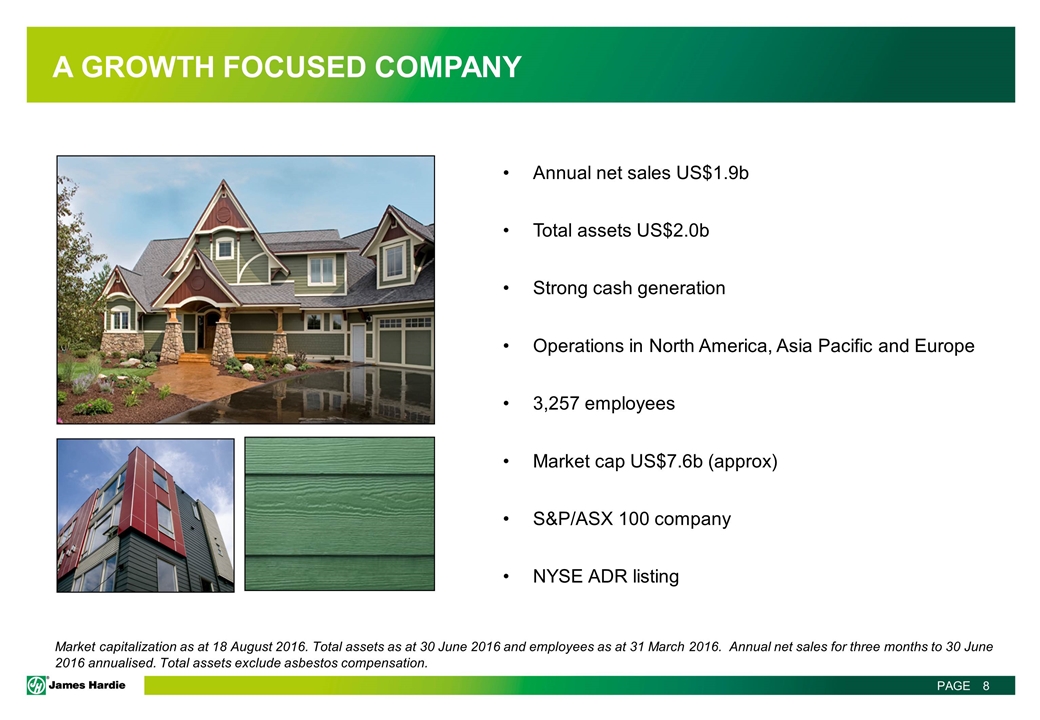
Annual net sales US$1.9b Total assets US$2.0b Strong cash generation Operations in North America, Asia Pacific and Europe 3,257 employees Market cap US$7.6b (approx) S&P/ASX 100 company NYSE ADR listing Market capitalization as at 18 August 2016. Total assets as at 30 June 2016 and employees as at 31 March 2016. Annual net sales for three months to 30 June 2016 annualised. Total assets exclude asbestos compensation. A GROWTH FOCUSED COMPANY
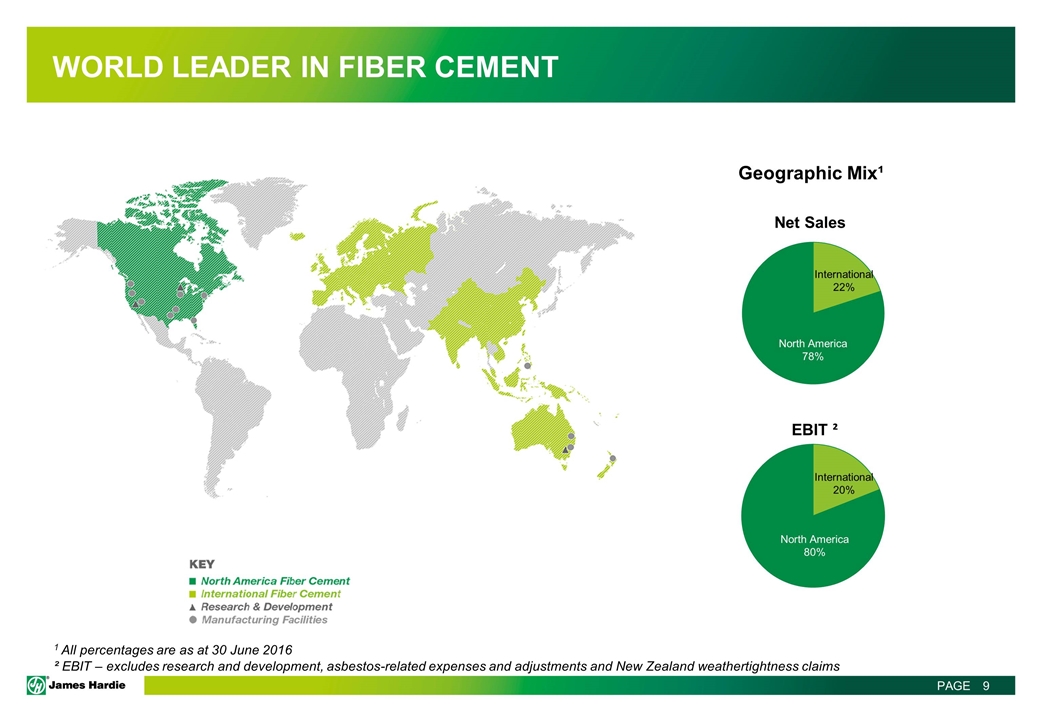
WORLD LEADER IN FIBER CEMENT Geographic Mix¹ Net Sales EBIT ² 1 All percentages are as at 30 June 2016 ² EBIT – excludes research and development, asbestos-related expenses and adjustments and New Zealand weathertightness claims International 20% International 22% North America 80%
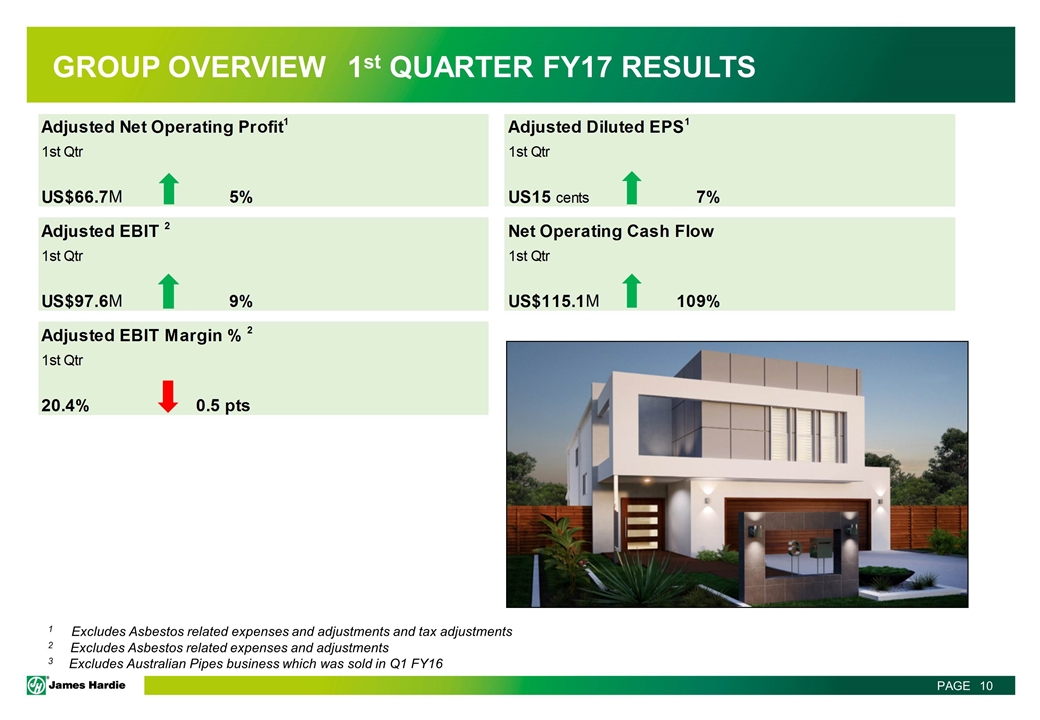
GROUP OVERVIEW 1st QUARTER FY17 RESULTS 1 Excludes Asbestos related expenses and adjustments and tax adjustments 2 Excludes Asbestos related expenses and adjustments 3 Excludes Australian Pipes business which was sold in Q1 FY16
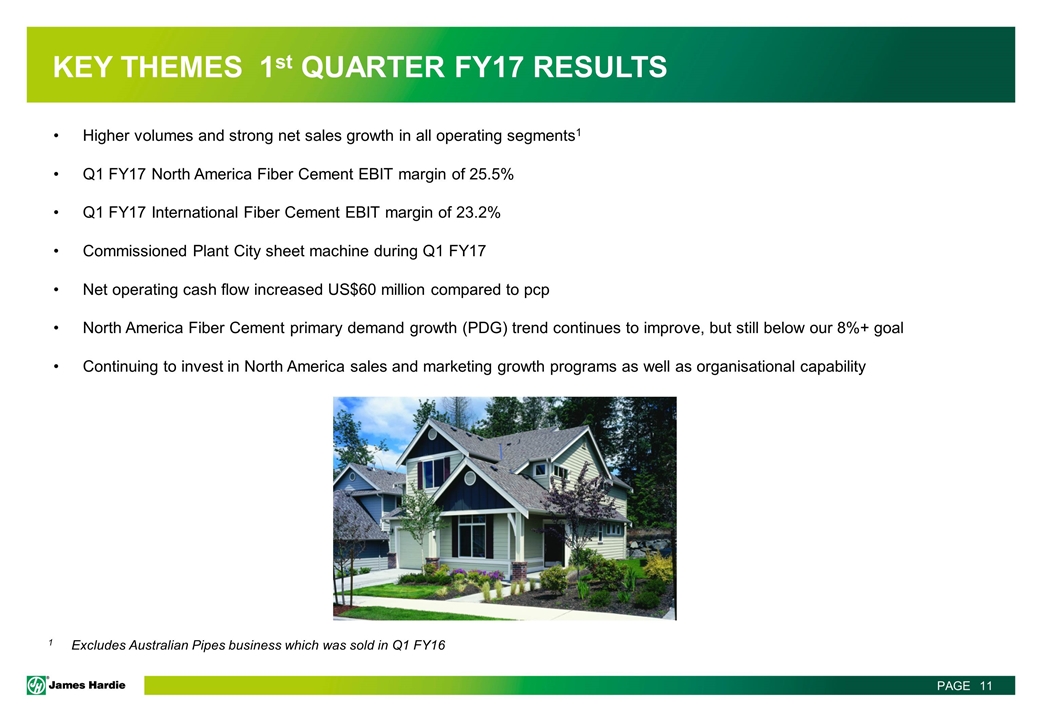
KEY THEMES 1st QUARTER FY17 RESULTS Higher volumes and strong net sales growth in all operating segments1 Q1 FY17 North America Fiber Cement EBIT margin of 25.5% Q1 FY17 International Fiber Cement EBIT margin of 23.2% Commissioned Plant City sheet machine during Q1 FY17 Net operating cash flow increased US$60 million compared to pcp North America Fiber Cement primary demand growth (PDG) trend continues to improve, but still below our 8%+ goal Continuing to invest in North America sales and marketing growth programs as well as organisational capability 1 Excludes Australian Pipes business which was sold in Q1 FY16
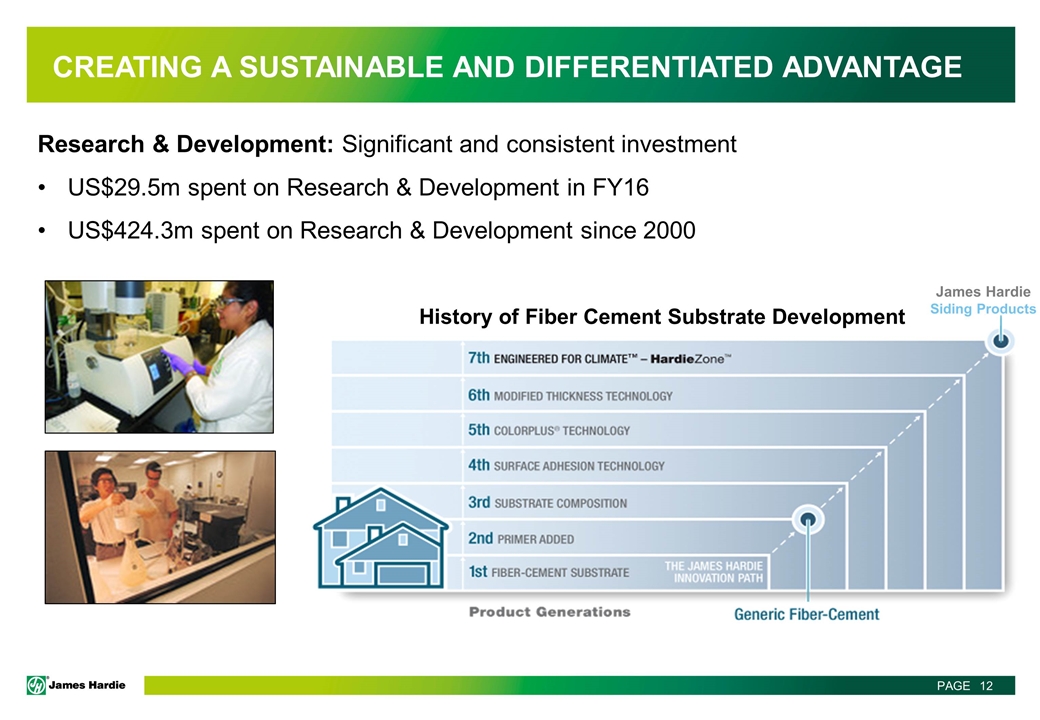
Research & Development: Significant and consistent investment US$29.5m spent on Research & Development in FY16 US$424.3m spent on Research & Development since 2000 CREATING A SUSTAINABLE AND DIFFERENTIATED ADVANTAGE History of Fiber Cement Substrate Development James Hardie Siding Products
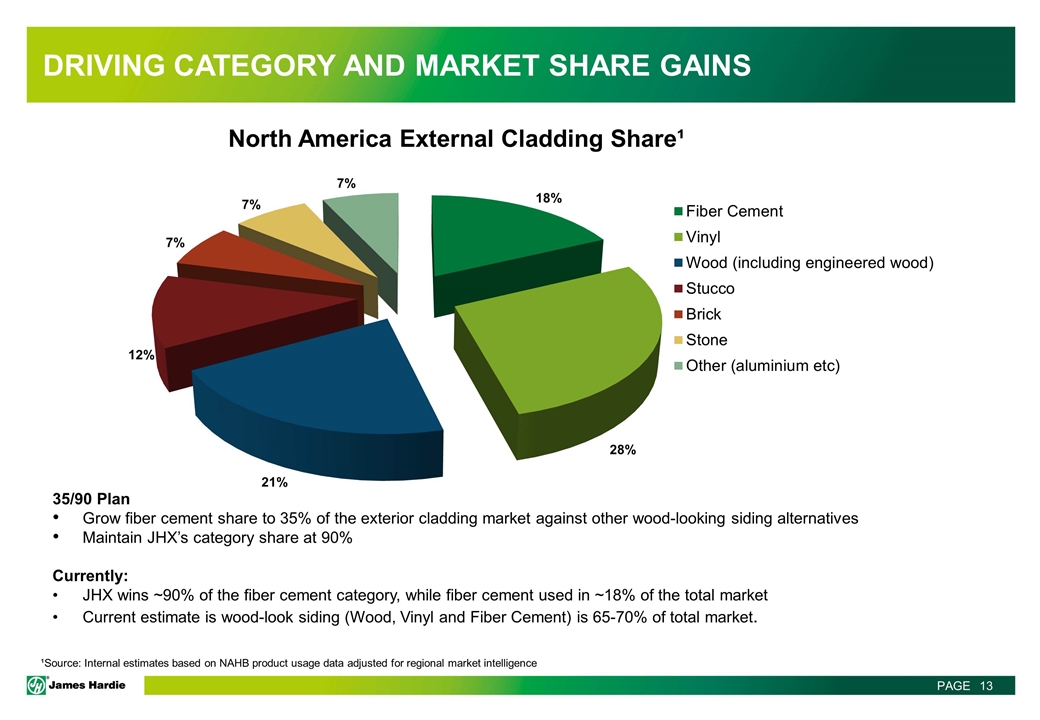
35/90 Plan Grow fiber cement share to 35% of the exterior cladding market against other wood-looking siding alternatives Maintain JHX’s category share at 90% Currently: JHX wins ~90% of the fiber cement category, while fiber cement used in ~18% of the total market Current estimate is wood-look siding (Wood, Vinyl and Fiber Cement) is 65-70% of total market. ¹Source: Internal estimates based on NAHB product usage data adjusted for regional market intelligence DRIVING CATEGORY AND MARKET SHARE GAINS North America External Cladding Share¹
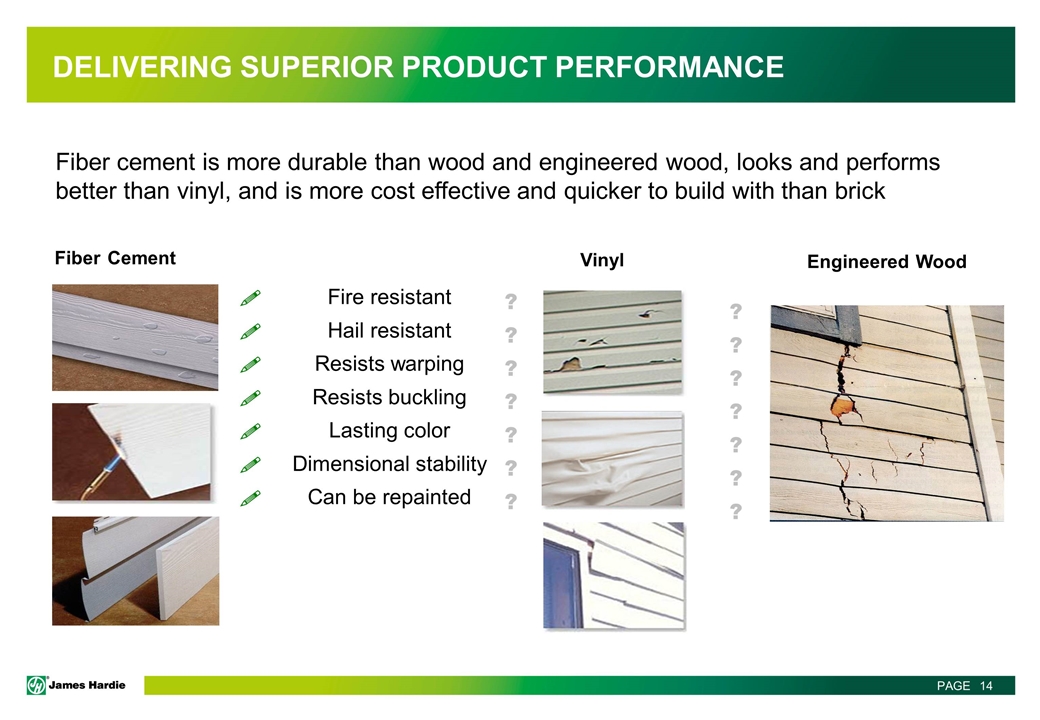
Fiber cement is more durable than wood and engineered wood, looks and performs better than vinyl, and is more cost effective and quicker to build with than brick Fiber Cement Vinyl Engineered Wood ! ! ! ! ! ! ! Fire resistant Hail resistant Resists warping Resists buckling Lasting color Dimensional stability Can be repainted ? ? ? ? ? ? ? ? ? ? ? ? ? ? DELIVERING SUPERIOR PRODUCT PERFORMANCE
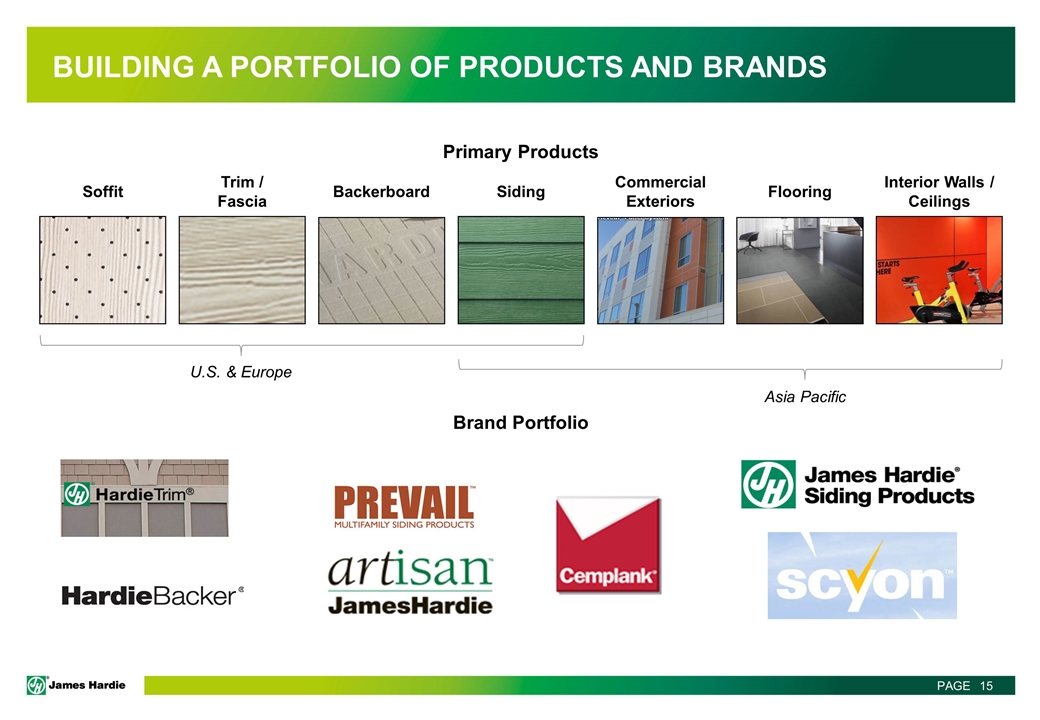
Siding Primary Products Soffit Trim / Fascia Backerboard Commercial Exteriors Flooring Interior Walls / Ceilings Brand Portfolio U.S. & Europe Asia Pacific BUILDING A PORTFOLIO OF PRODUCTS AND BRANDS
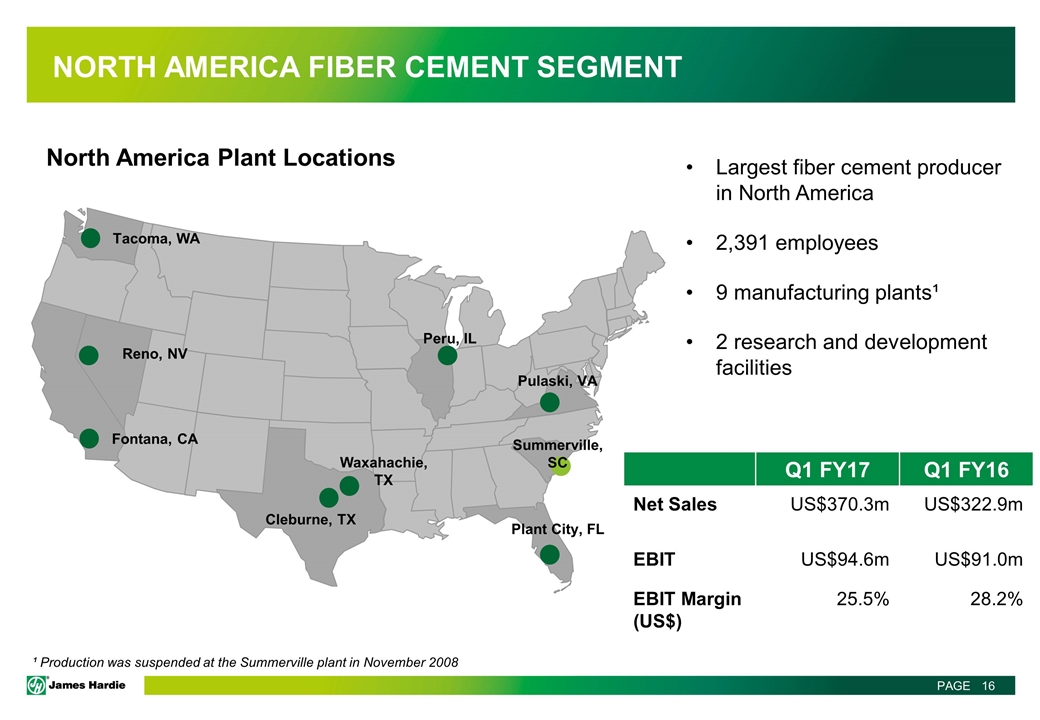
¹ Production was suspended at the Summerville plant in November 2008 North America Plant Locations NORTH AMERICA FIBER CEMENT SEGMENT Tacoma, WA Reno, NV Fontana, CA Waxahachie, TX Cleburne, TX Summerville, SC Plant City, FL Pulaski, VA Peru, IL Largest fiber cement producer in North America 2,391 employees 9 manufacturing plants¹ 2 research and development facilities Q1 FY17 Q1 FY16 Net Sales US$370.3m US$322.9m EBIT US$94.6m US$91.0m EBIT Margin (US$) 25.5% 28.2%
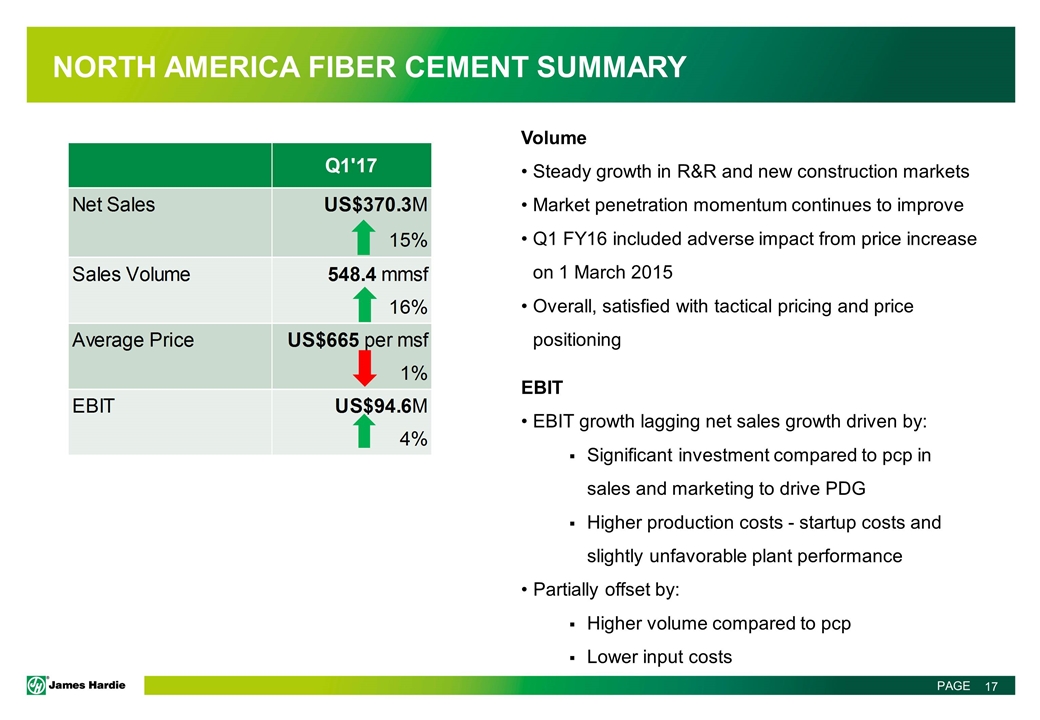
NORTH AMERICA FIBER CEMENT SUMMARY Volume Steady growth in R&R and new construction markets Market penetration momentum continues to improve Q1 FY16 included adverse impact from price increase on 1 March 2015 Overall, satisfied with tactical pricing and price positioning EBIT EBIT growth lagging net sales growth driven by: Significant investment compared to pcp in sales and marketing to drive PDG Higher production costs - startup costs and slightly unfavorable plant performance Partially offset by: Higher volume compared to pcp Lower input costs
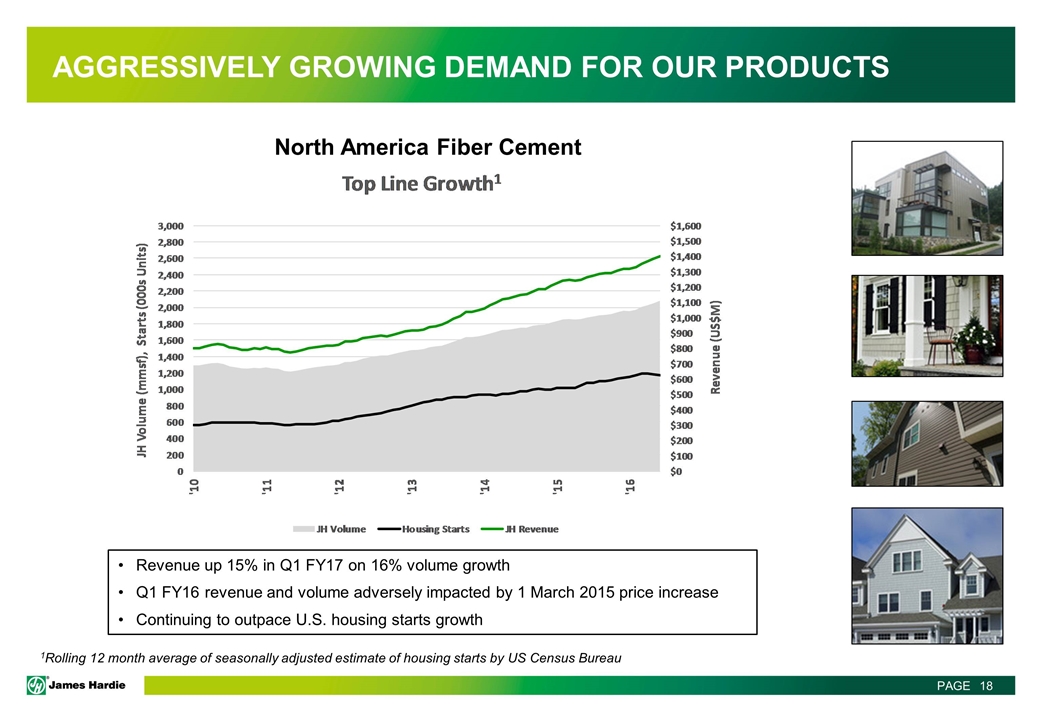
1Rolling 12 month average of seasonally adjusted estimate of housing starts by US Census Bureau AGGRESSIVELY GROWING DEMAND FOR OUR PRODUCTS North America Fiber Cement Revenue up 15% in Q1 FY17 on 16% volume growth Q1 FY16 revenue and volume adversely impacted by 1 March 2015 price increase Continuing to outpace U.S. housing starts growth

North America Fiber Cement ACHIEVING THE RIGHT VALUE FOR OUR PRODUCTS Price essentially flat due to maintaining current strategic pricing levels and the ongoing execution of tactical pricing strategies Overall, satisfied with tactical pricing and price positioning
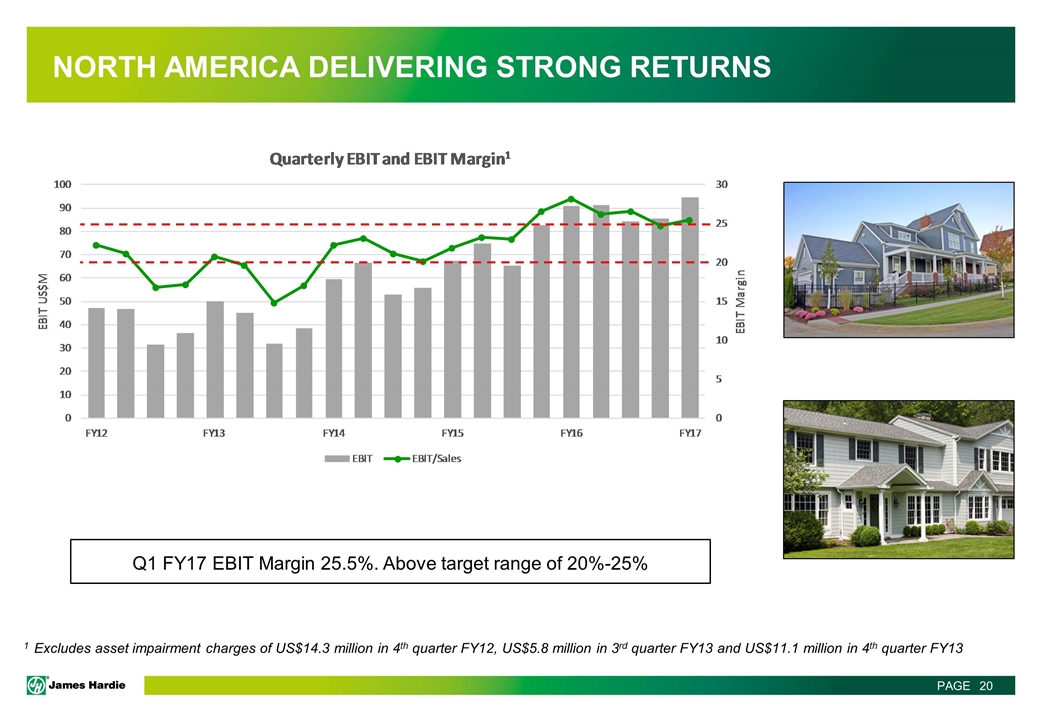
NORTH AMERICA DELIVERING STRONG RETURNS 1 Excludes asset impairment charges of US$14.3 million in 4th quarter FY12, US$5.8 million in 3rd quarter FY13 and US$11.1 million in 4th quarter FY13 Q1 FY17 EBIT Margin 25.5%. Above target range of 20%-25%
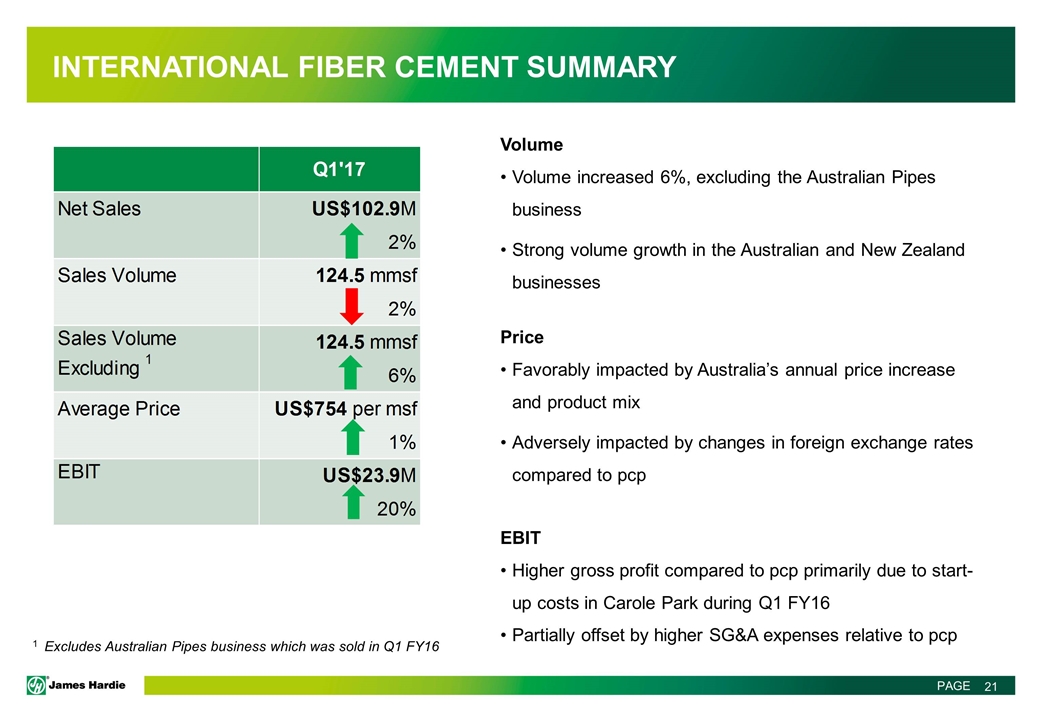
Volume Volume increased 6%, excluding the Australian Pipes business Strong volume growth in the Australian and New Zealand businesses Price Favorably impacted by Australia’s annual price increase and product mix Adversely impacted by changes in foreign exchange rates compared to pcp EBIT Higher gross profit compared to pcp primarily due to start-up costs in Carole Park during Q1 FY16 Partially offset by higher SG&A expenses relative to pcp INTERNATIONAL FIBER CEMENT SUMMARY 1 Excludes Australian Pipes business which was sold in Q1 FY16
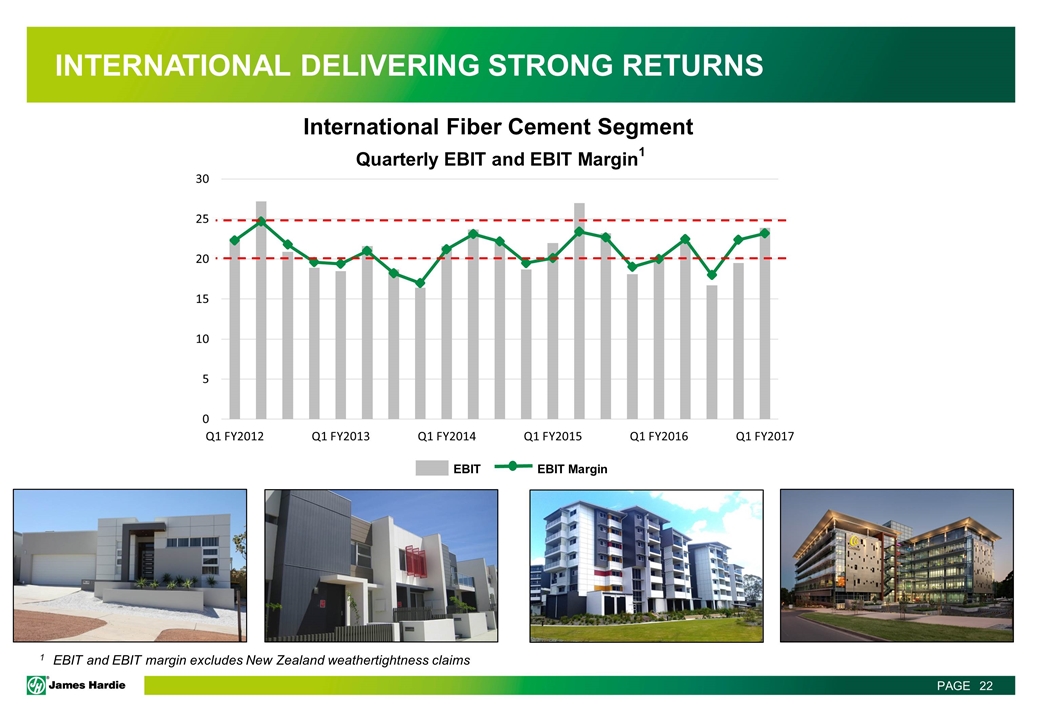
INTERNATIONAL DELIVERING STRONG RETURNS 1 EBIT and EBIT margin excludes New Zealand weathertightness claims Quarterly EBIT and EBIT Margin1 EBIT EBIT Margin International Fiber Cement Segment
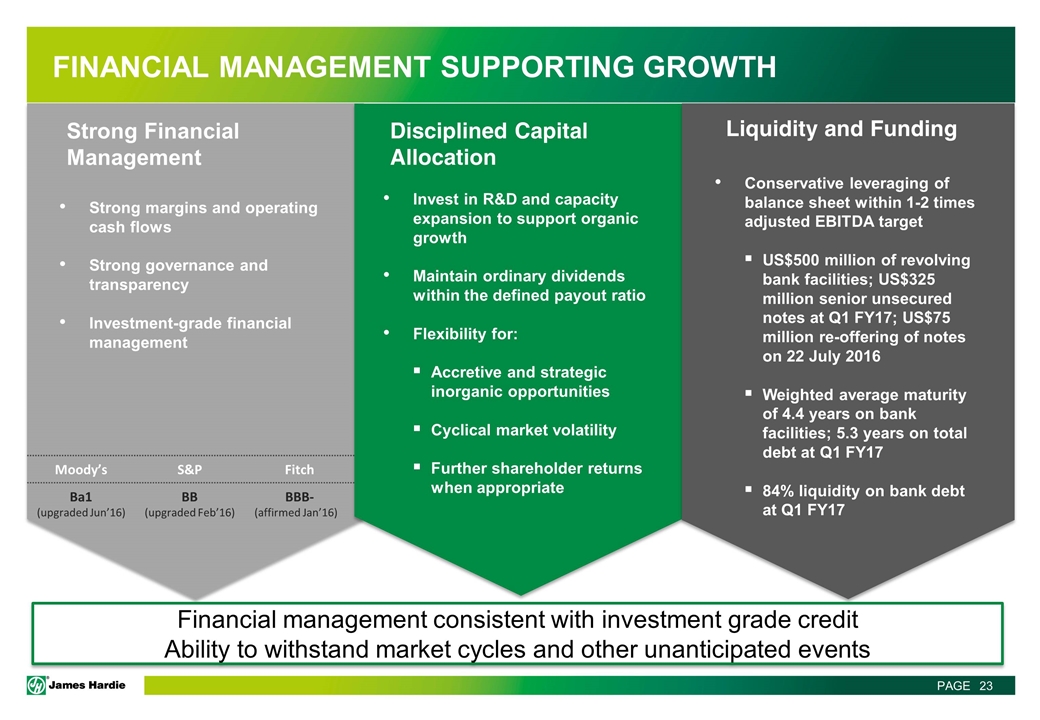
FINANCIAL MANAGEMENT SUPPORTING GROWTH Strong Financial Management Disciplined Capital Allocation Liquidity and Funding Strong margins and operating cash flows Strong governance and transparency Investment-grade financial management Invest in R&D and capacity expansion to support organic growth Maintain ordinary dividends within the defined payout ratio Flexibility for: Accretive and strategic inorganic opportunities Cyclical market volatility Further shareholder returns when appropriate Conservative leveraging of balance sheet within 1-2 times adjusted EBITDA target US$500 million of revolving bank facilities; US$325 million senior unsecured notes at Q1 FY17; US$75 million re-offering of notes on 22 July 2016 Weighted average maturity of 4.4 years on bank facilities; 5.3 years on total debt at Q1 FY17 84% liquidity on bank debt at Q1 FY17 Financial management consistent with investment grade credit Ability to withstand market cycles and other unanticipated events Moody’s S&P Fitch Ba1 (upgraded Jun’16) BB (upgraded Feb’16) BBB- (affirmed Jan’16)

FY2017 GUIDANCE Management notes the range of analysts’ forecasts for net operating profit excluding asbestos for the year ending 31 March 2017 is between US$264 million and US$285 million¹ Management expects full year Adjusted net operating profit to be between US$260 million and US$290 million assuming, among other things, housing conditions in the United States continue to improve in line with our assumed forecast of new construction starts between approximately 1.2 and 1.3 million, and input prices and an average USD/AUD exchange rate that is at or near current levels for the remainder of the year Management cautions that although US housing activity has been improving, market conditions remain somewhat uncertain and some input costs remain volatile. Management is unable to forecast the comparable US GAAP financial measure due to uncertainty regarding the impact of actuarial estimates on asbestos-related assets and liabilities in future periods 1 Analysts’ forecasts as at 31 August 2016
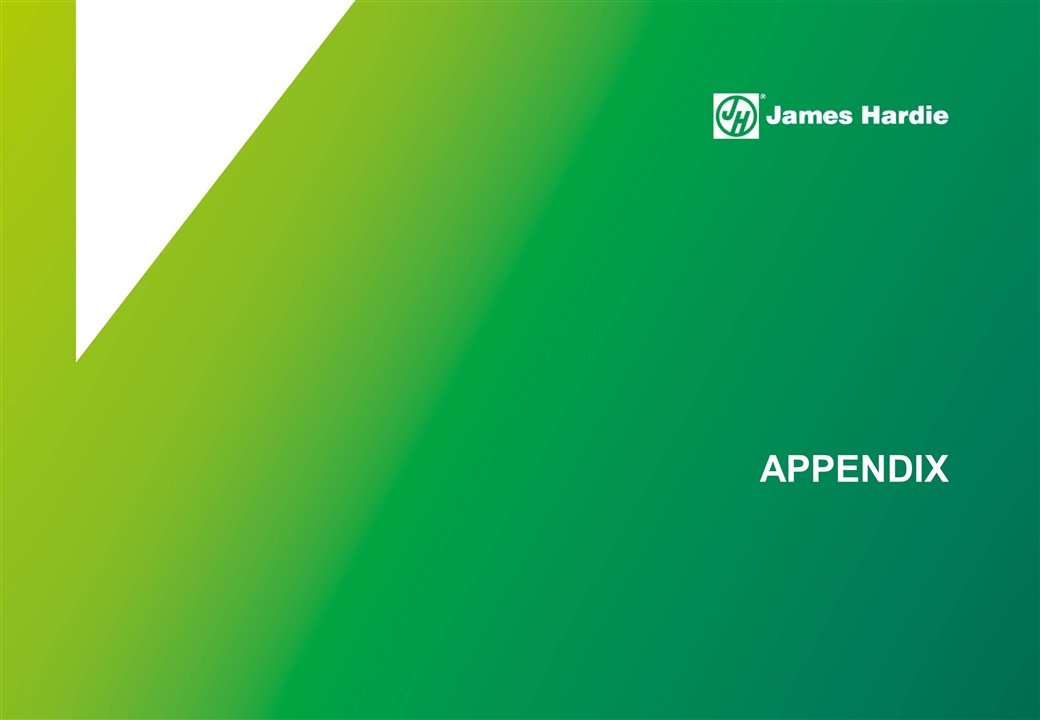
APPENDIX
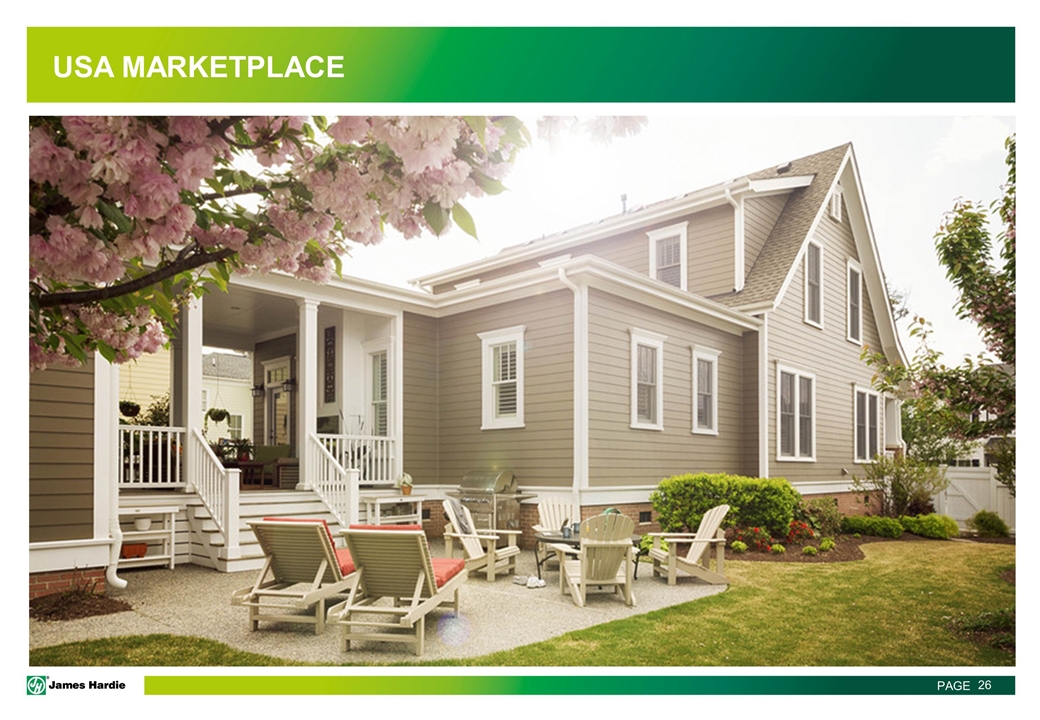
USA MARKETPLACE

AUSTRALIA & NEW ZEALAND MARKETPLACE
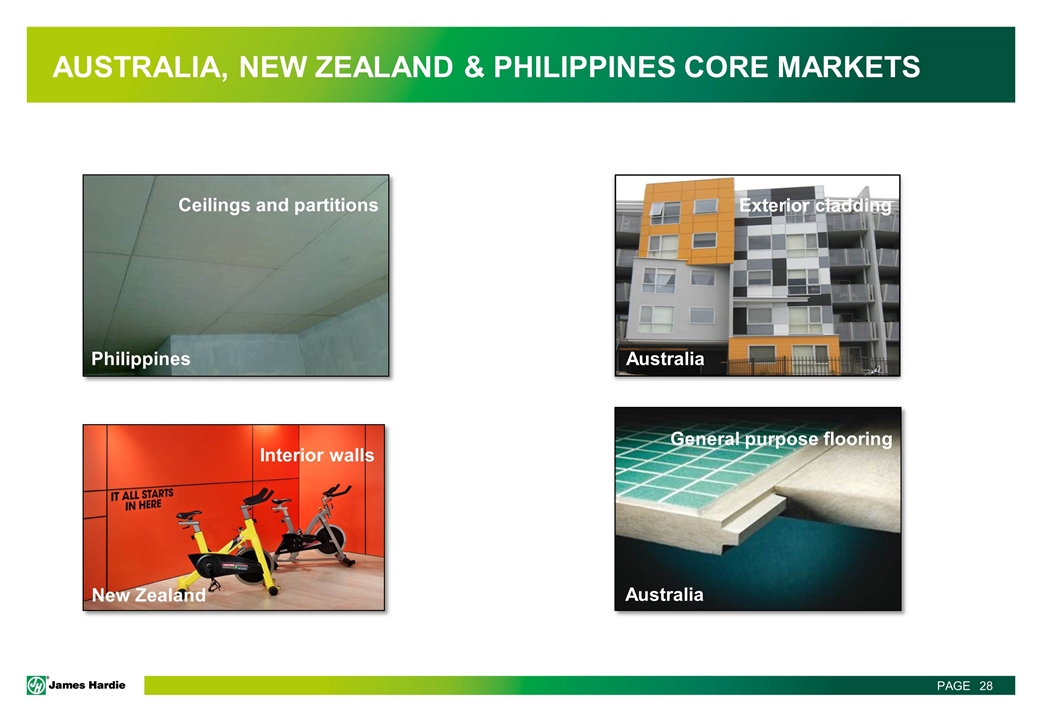
Ceilings and partitions Philippines Exterior cladding Australia General purpose flooring Australia New Zealand Interior walls AUSTRALIA, NEW ZEALAND & PHILIPPINES CORE MARKETS

FINANCIAL SUMMARY 1 Excludes Asbestos related expenses and adjustments
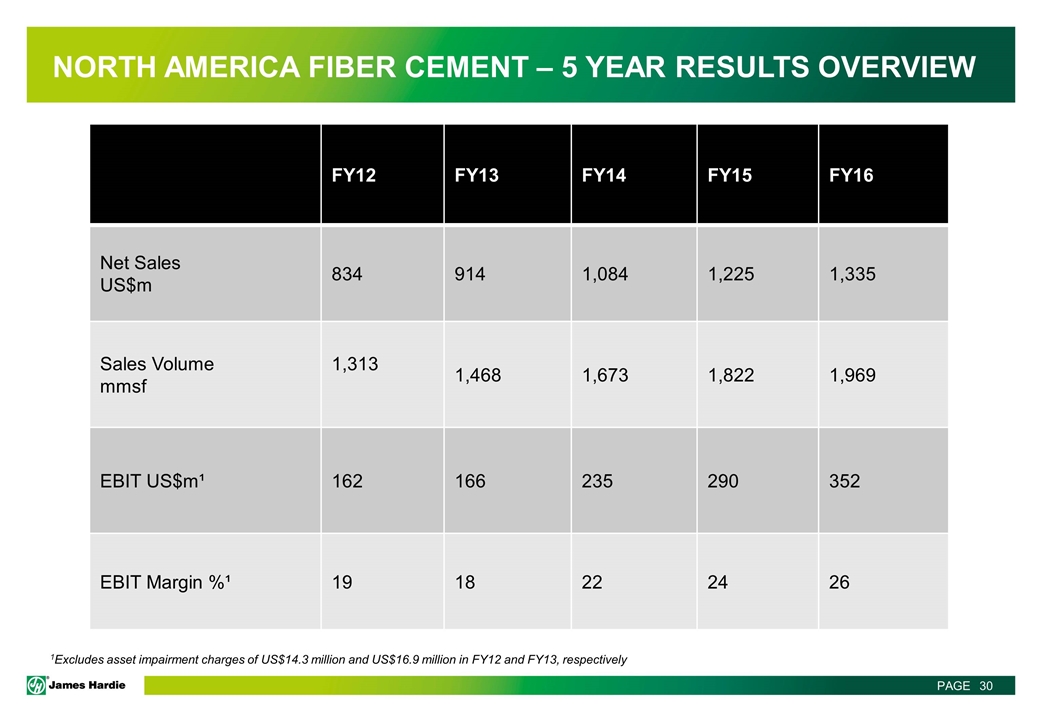
FY12 FY13 FY14 FY15 FY16 Net Sales US$m 834 914 1,084 1,225 1,335 Sales Volume mmsf 1,313 1,468 1,673 1,822 1,969 EBIT US$m¹ 162 166 235 290 352 EBIT Margin %¹ 19 18 22 24 26 1Excludes asset impairment charges of US$14.3 million and US$16.9 million in FY12 and FY13, respectively NORTH AMERICA FIBER CEMENT – 5 YEAR RESULTS OVERVIEW
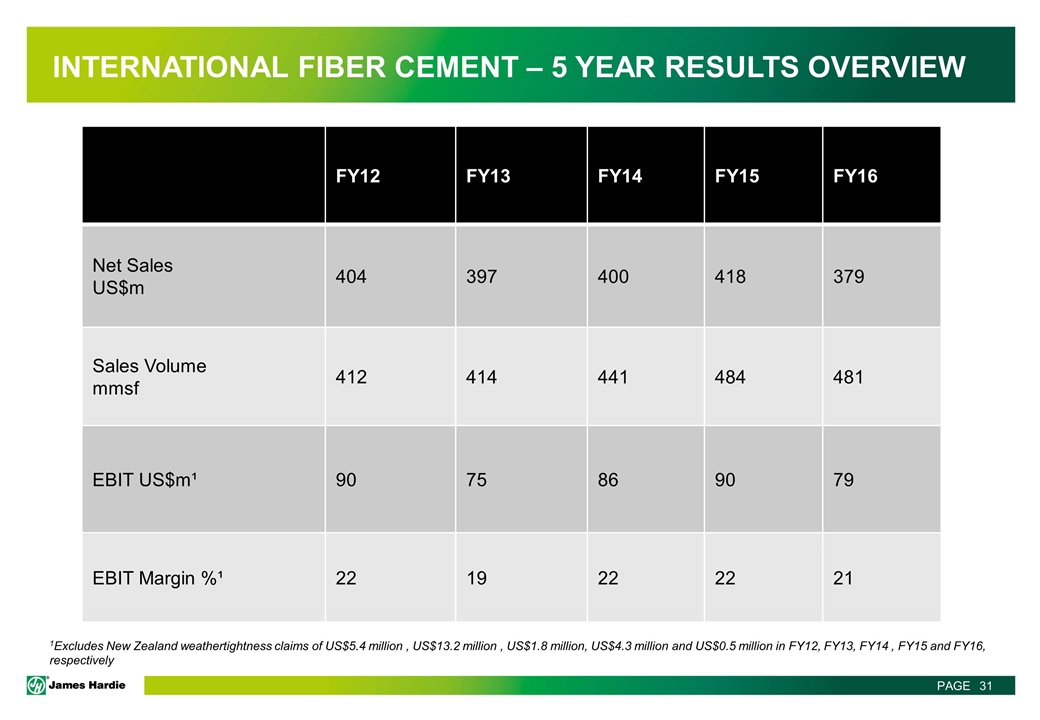
1Excludes New Zealand weathertightness claims of US$5.4 million , US$13.2 million , US$1.8 million, US$4.3 million and US$0.5 million in FY12, FY13, FY14 , FY15 and FY16, respectively FY12 FY13 FY14 FY15 FY16 Net Sales US$m 404 397 400 418 379 Sales Volume mmsf 412 414 441 484 481 EBIT US$m¹ 90 75 86 90 79 EBIT Margin %¹ 22 19 22 22 21 INTERNATIONAL FIBER CEMENT – 5 YEAR RESULTS OVERVIEW

Net sales increased 12% Higher volume in all operating segments3 Higher average net sales price in International Fiber Cement segment Adversely impacted by stronger USD Gross profit increased 12%; gross margin increased 20 bps Top line growth slightly out paced increase in COGS SG&A expenses increased 17% Driven by continued higher investment in sales and marketing related to PDG initiatives Adjusted net operating profit increased 5% Adjusted EBIT increased 9% compared to pcp Increase in other expense of US$3.4 million Increase in Adjusted income tax of US$1.9 million RESULTS – 1st QUARTER FY17 1 Excludes Asbestos related expenses and adjustments 2 Excludes Asbestos related expenses and adjustments and tax adjustments 3 Excludes Australian Pipes business which was sold in Q1 FY16
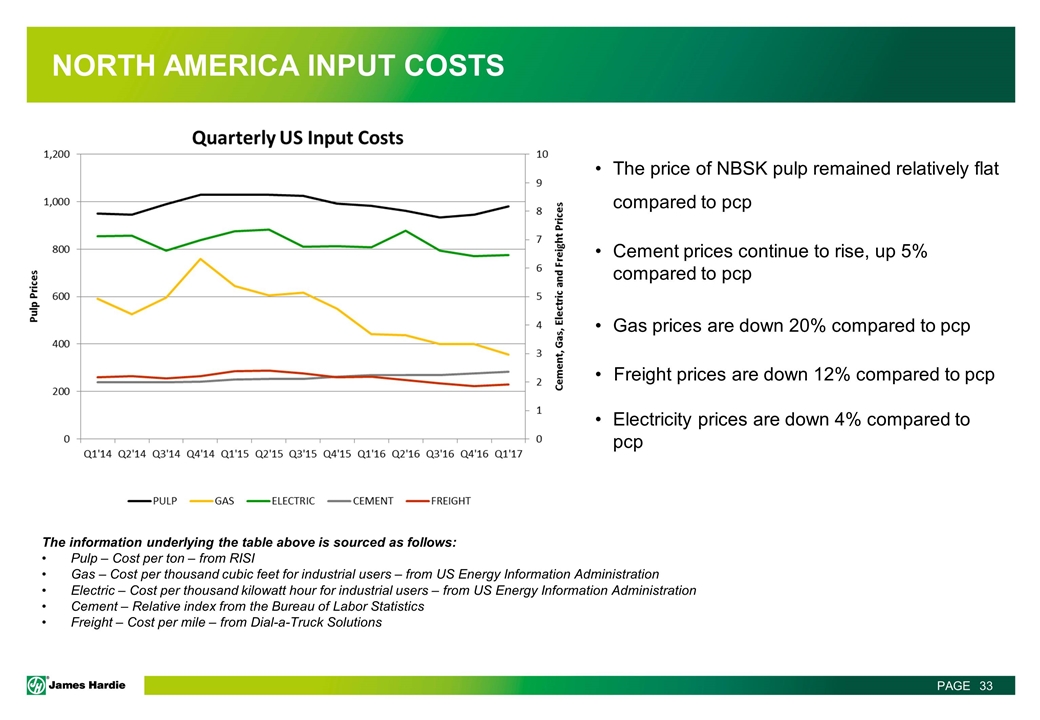
NORTH AMERICA INPUT COSTS The price of NBSK pulp remained relatively flat compared to pcp Cement prices continue to rise, up 5% compared to pcp Gas prices are down 20% compared to pcp Freight prices are down 12% compared to pcp Electricity prices are down 4% compared to pcp The information underlying the table above is sourced as follows: Pulp – Cost per ton – from RISI Gas – Cost per thousand cubic feet for industrial users – from US Energy Information Administration Electric – Cost per thousand kilowatt hour for industrial users – from US Energy Information Administration Cement – Relative index from the Bureau of Labor Statistics Freight – Cost per mile – from Dial-a-Truck Solutions
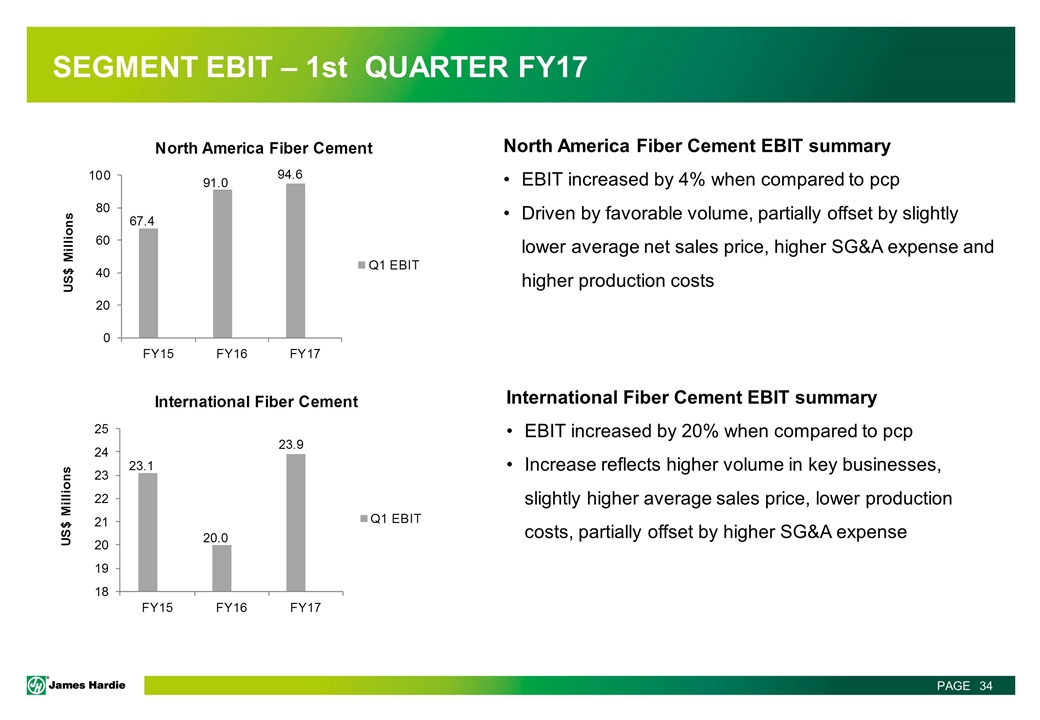
North America Fiber Cement EBIT summary EBIT increased by 4% when compared to pcp Driven by favorable volume, partially offset by slightly lower average net sales price, higher SG&A expense and higher production costs SEGMENT EBIT – 1st QUARTER FY17 International Fiber Cement EBIT summary EBIT increased by 20% when compared to pcp Increase reflects higher volume in key businesses, slightly higher average sales price, lower production costs, partially offset by higher SG&A expense
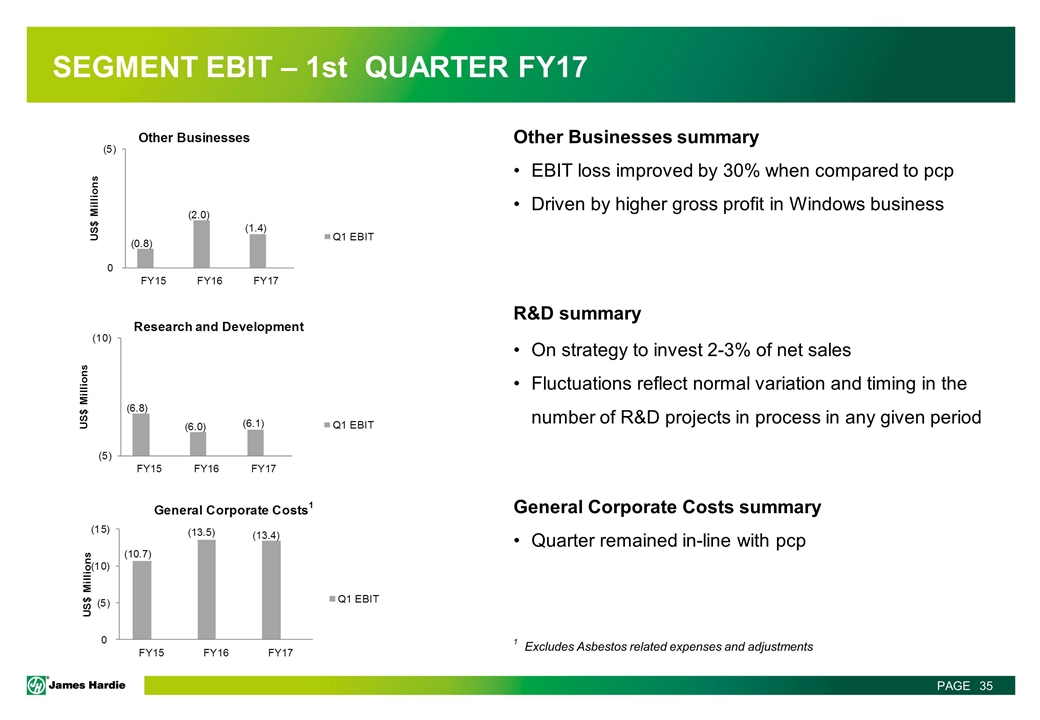
Other Businesses summary EBIT loss improved by 30% when compared to pcp Driven by higher gross profit in Windows business R&D summary On strategy to invest 2-3% of net sales Fluctuations reflect normal variation and timing in the number of R&D projects in process in any given period General Corporate Costs summary Quarter remained in-line with pcp SEGMENT EBIT – 1st QUARTER FY17 1 Excludes Asbestos related expenses and adjustments
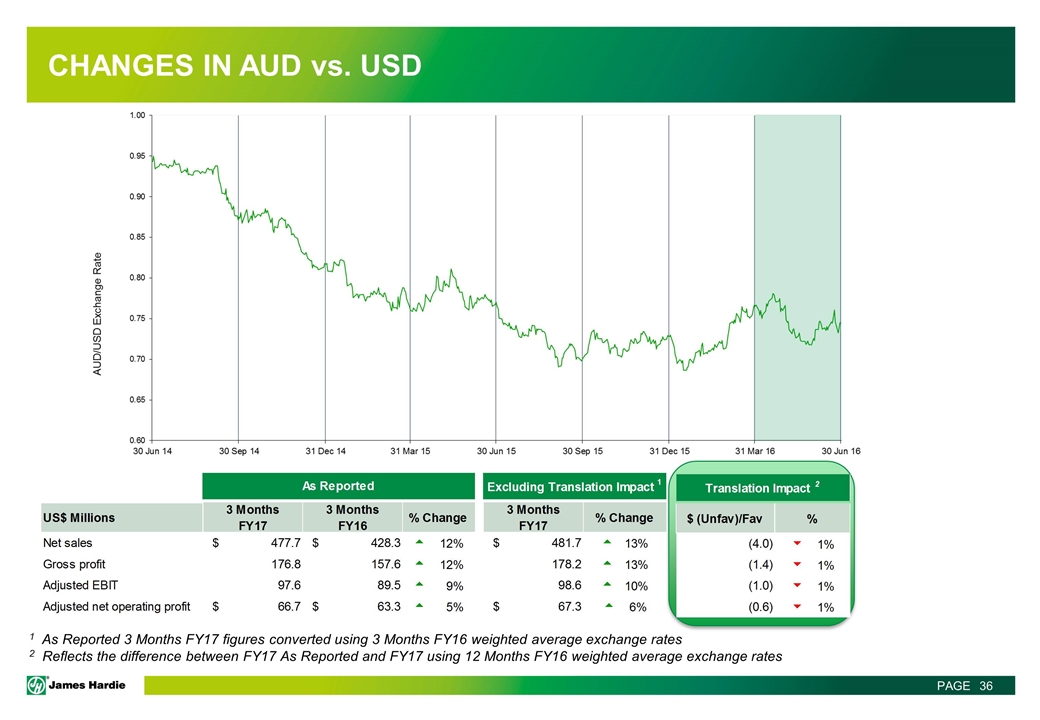
CHANGES IN AUD vs. USD 1 As Reported 3 Months FY17 figures converted using 3 Months FY16 weighted average exchange rates 2 Reflects the difference between FY17 As Reported and FY17 using 12 Months FY16 weighted average exchange rates
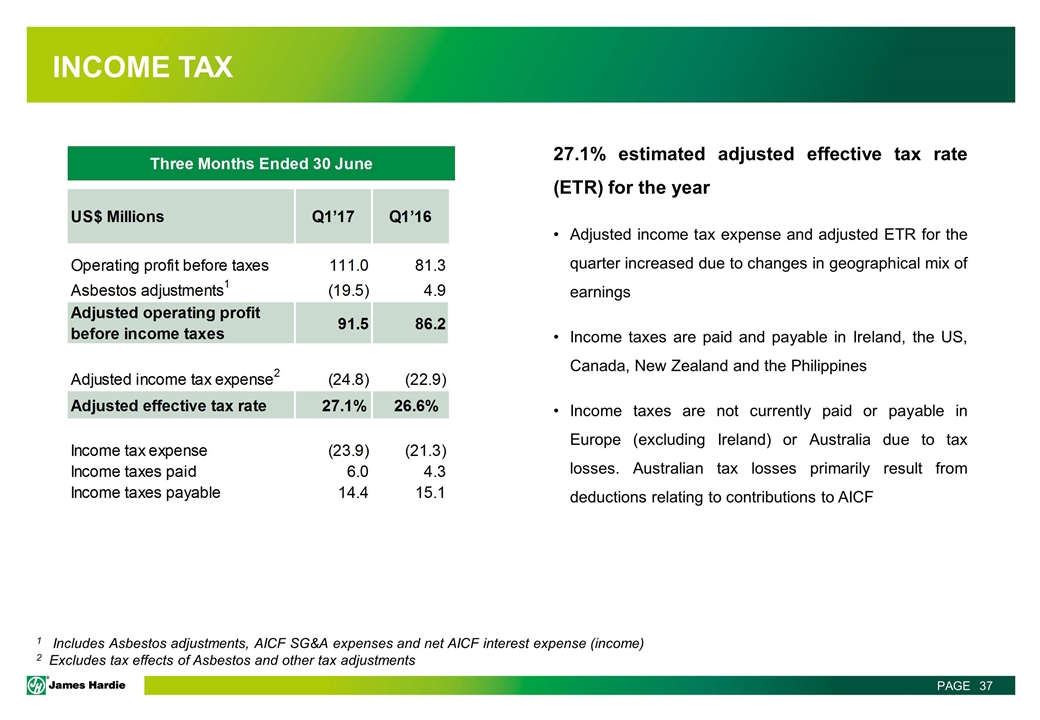
1 Includes Asbestos adjustments, AICF SG&A expenses and net AICF interest expense (income) 2 Excludes tax effects of Asbestos and other tax adjustments 27.1% estimated adjusted effective tax rate (ETR) for the year Adjusted income tax expense and adjusted ETR for the quarter increased due to changes in geographical mix of earnings Income taxes are paid and payable in Ireland, the US, Canada, New Zealand and the Philippines Income taxes are not currently paid or payable in Europe (excluding Ireland) or Australia due to tax losses. Australian tax losses primarily result from deductions relating to contributions to AICF INCOME TAX

1 CASHFLOW Increase in net operating cash flow: Favorable change in working capital due to increased sales and normal variation related to timing in AR4 and AP4 Increase in net income adjusted for non-cash items Capital expenditures down slightly compared to pcp Higher financing activities due to increase in net repayments of borrowings 1 Certain prior year balances have been reclassified to conform to the current year presentation 2 Excludes AP related to capital expenditures 3 Includes capitalized interest 4 Accounts receivable (“AR”) and Accounts payable (“AP”)
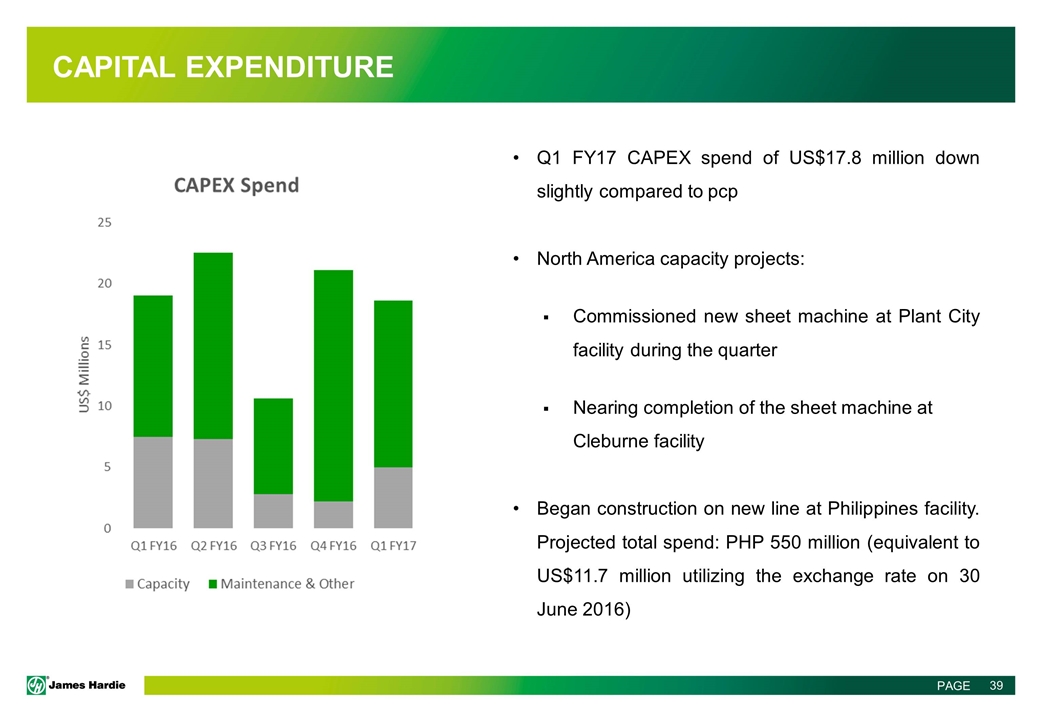
CAPITAL EXPENDITURE Q1 FY17 CAPEX spend of US$17.8 million down slightly compared to pcp North America capacity projects: Commissioned new sheet machine at Plant City facility during the quarter Nearing completion of the sheet machine at Cleburne facility Began construction on new line at Philippines facility. Projected total spend: PHP 550 million (equivalent to US$11.7 million utilizing the exchange rate on 30 June 2016)

LIQUIDITY PROFILE Corporate debt structure US$500 million revolving credit facility, with a December 2020 maturity US$325 million 8 year senior unsecured notes2 US$75 million re-offering of the 2023 senior unsecured notes issued at 103% of par value (5.327% yield to maturity) on 22 July 2016 Strong balance sheet US$94.8 million cash US$297.6 million net debt 3,4 at Q1 FY17 84% liquidity on bank debt at Q1 FY17 Floating rate bank debt drawn through the quarter was, on average, 79% hedged with interest rate swaps that carry a weighted average fixed rate of 2.04% 0.6x net debt to EBITDA excluding asbestos at 30 June 2016, which increased to 0.8x on 1 July 2016 to facilitate the AICF payment 1 Incremental liquidity of up to US$250 million may be accessed via an accordion feature, which is provided for under the terms of the syndicated revolving credit facility agreement, but not credit approved 2 Callable from 15 February 2018; callable at par from 15 February 2021 3 Net of original issue discount and expenses 4 Excludes Short-term debt - Asbestos US$80m bank facilities drawn at Q1 FY17; US$94.8m held in cash
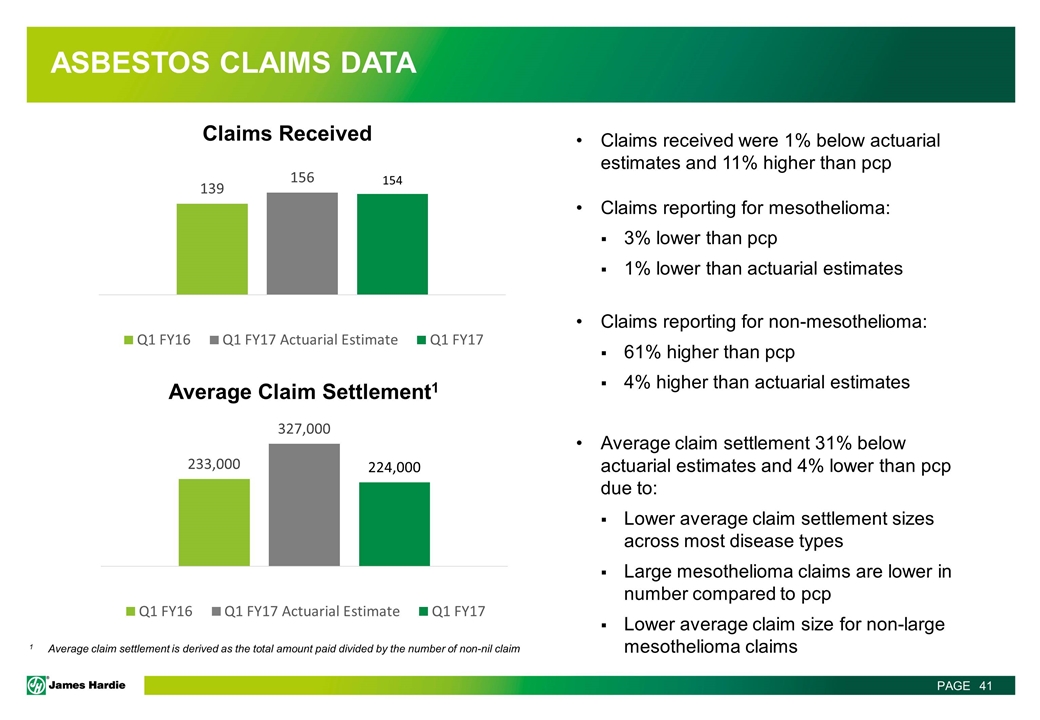
ASBESTOS CLAIMS DATA Claims received were 1% below actuarial estimates and 11% higher than pcp Claims reporting for mesothelioma: 3% lower than pcp 1% lower than actuarial estimates Claims reporting for non-mesothelioma: 61% higher than pcp 4% higher than actuarial estimates Average claim settlement 31% below actuarial estimates and 4% lower than pcp due to: Lower average claim settlement sizes across most disease types Large mesothelioma claims are lower in number compared to pcp Lower average claim size for non-large mesothelioma claims 1 Average claim settlement is derived as the total amount paid divided by the number of non-nil claim Claims Received Average Claim Settlement1
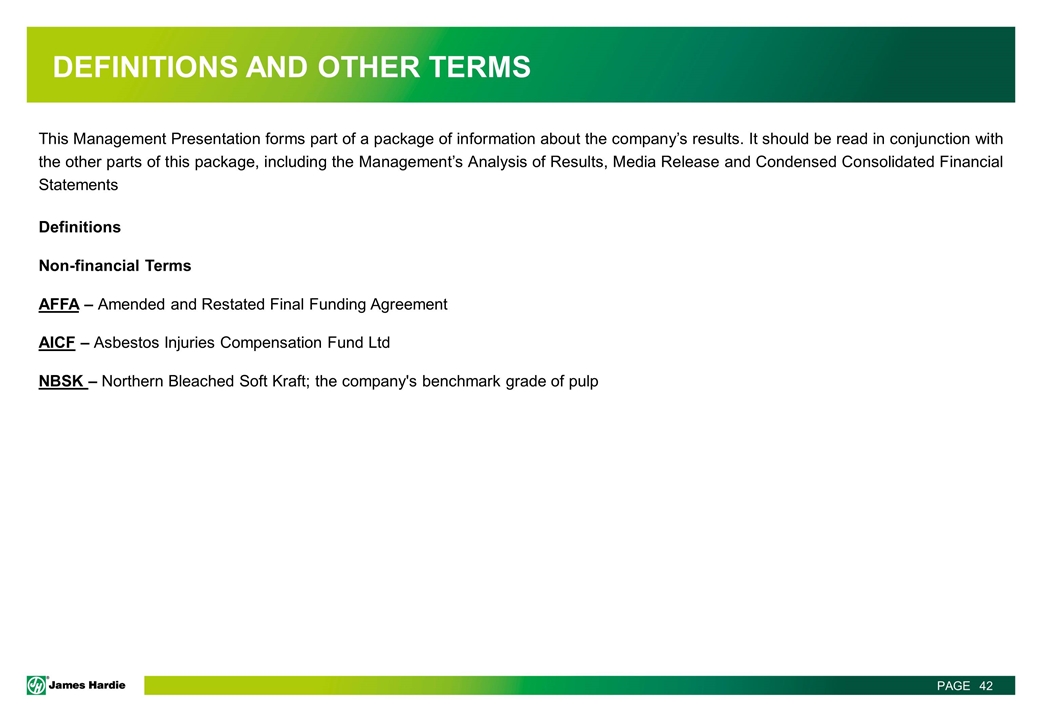
DEFINITIONS AND OTHER TERMS This Management Presentation forms part of a package of information about the company’s results. It should be read in conjunction with the other parts of this package, including the Management’s Analysis of Results, Media Release and Condensed Consolidated Financial Statements Definitions Non-financial Terms AFFA – Amended and Restated Final Funding Agreement AICF – Asbestos Injuries Compensation Fund Ltd NBSK – Northern Bleached Soft Kraft; the company's benchmark grade of pulp
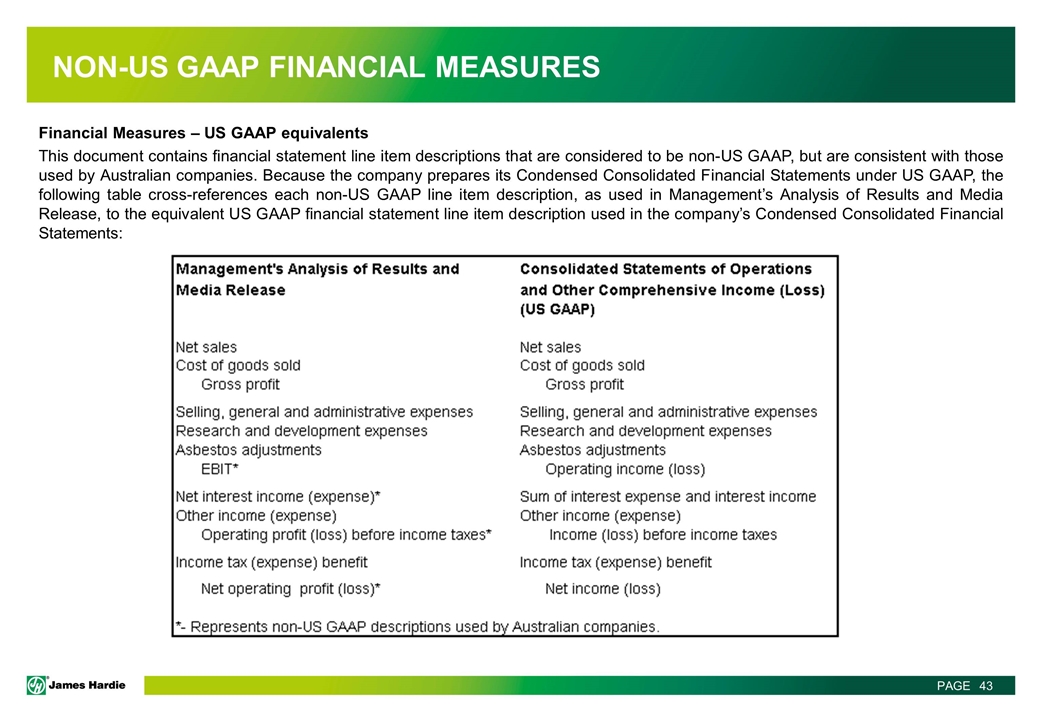
NON-US GAAP FINANCIAL MEASURES Financial Measures – US GAAP equivalents This document contains financial statement line item descriptions that are considered to be non-US GAAP, but are consistent with those used by Australian companies. Because the company prepares its Condensed Consolidated Financial Statements under US GAAP, the following table cross-references each non-US GAAP line item description, as used in Management’s Analysis of Results and Media Release, to the equivalent US GAAP financial statement line item description used in the company’s Condensed Consolidated Financial Statements:
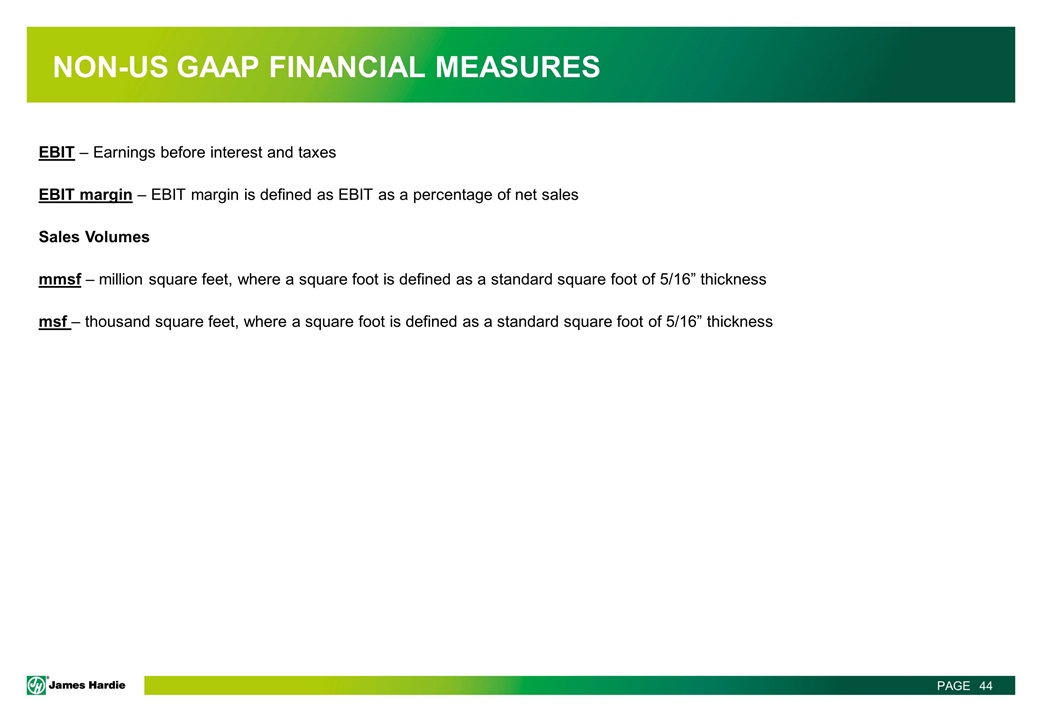
NON-US GAAP FINANCIAL MEASURES EBIT – Earnings before interest and taxes EBIT margin – EBIT margin is defined as EBIT as a percentage of net sales Sales Volumes mmsf – million square feet, where a square foot is defined as a standard square foot of 5/16” thickness msf – thousand square feet, where a square foot is defined as a standard square foot of 5/16” thickness
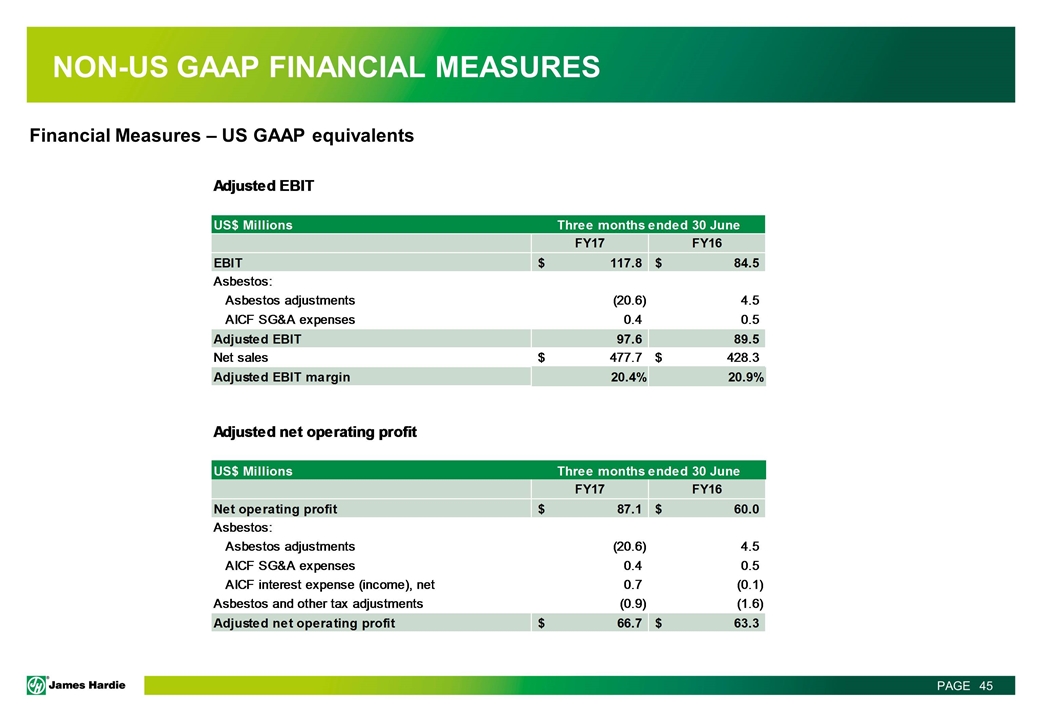
Financial Measures – US GAAP equivalents NON-US GAAP FINANCIAL MEASURES
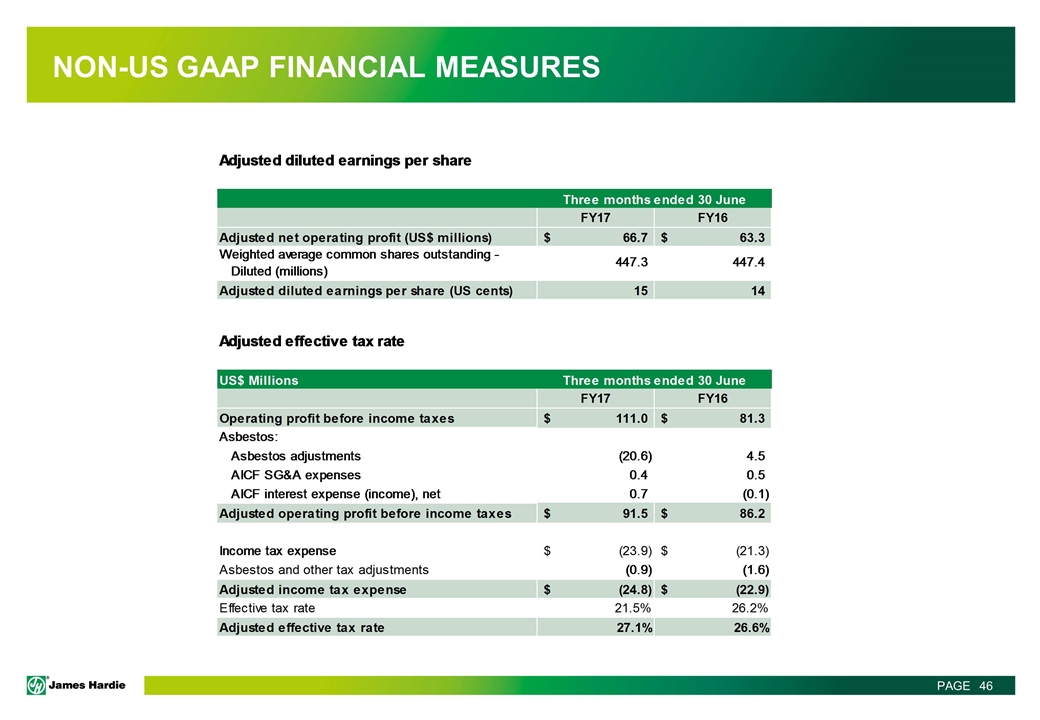
NON-US GAAP FINANCIAL MEASURES
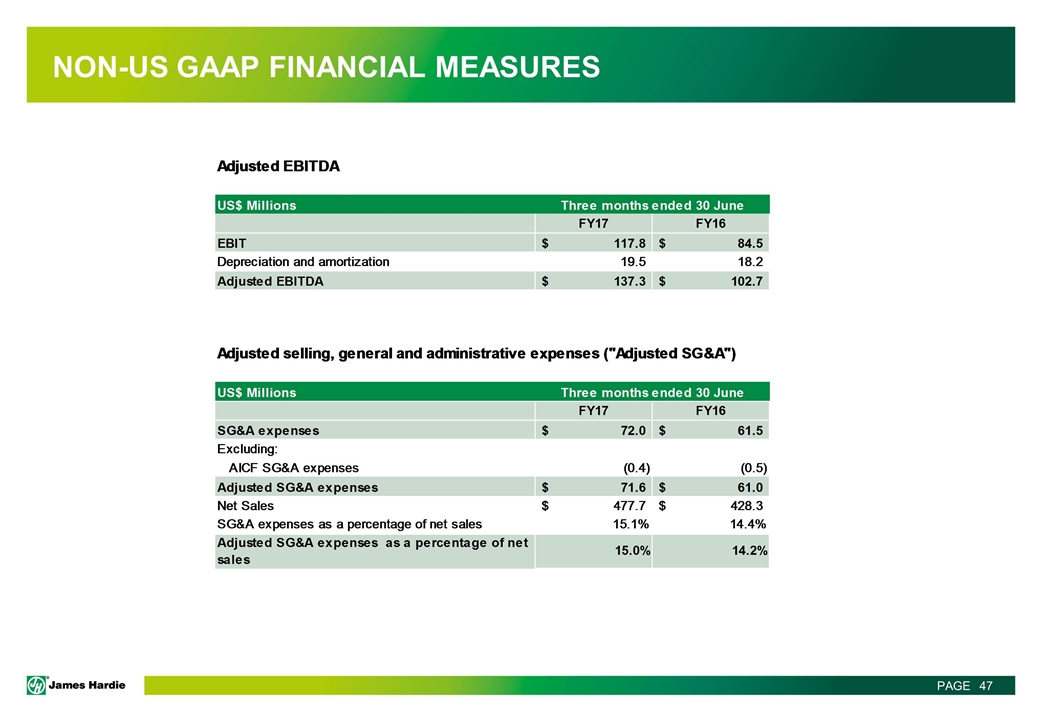
NON-US GAAP FINANCIAL MEASURES
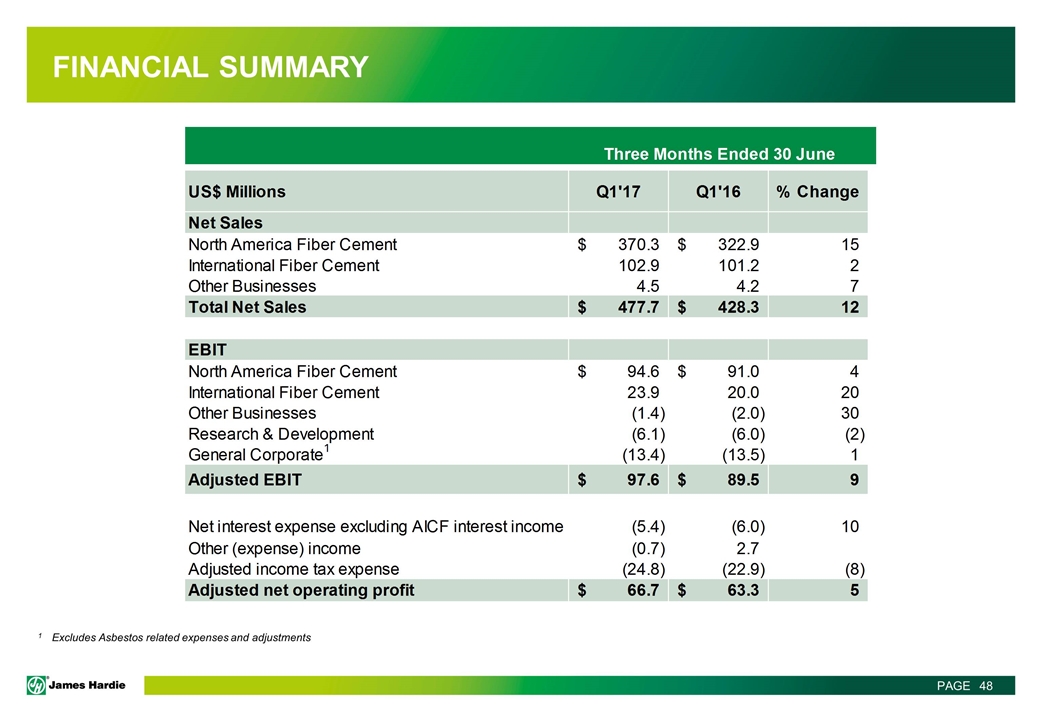
FINANCIAL SUMMARY 1 Excludes Asbestos related expenses and adjustments
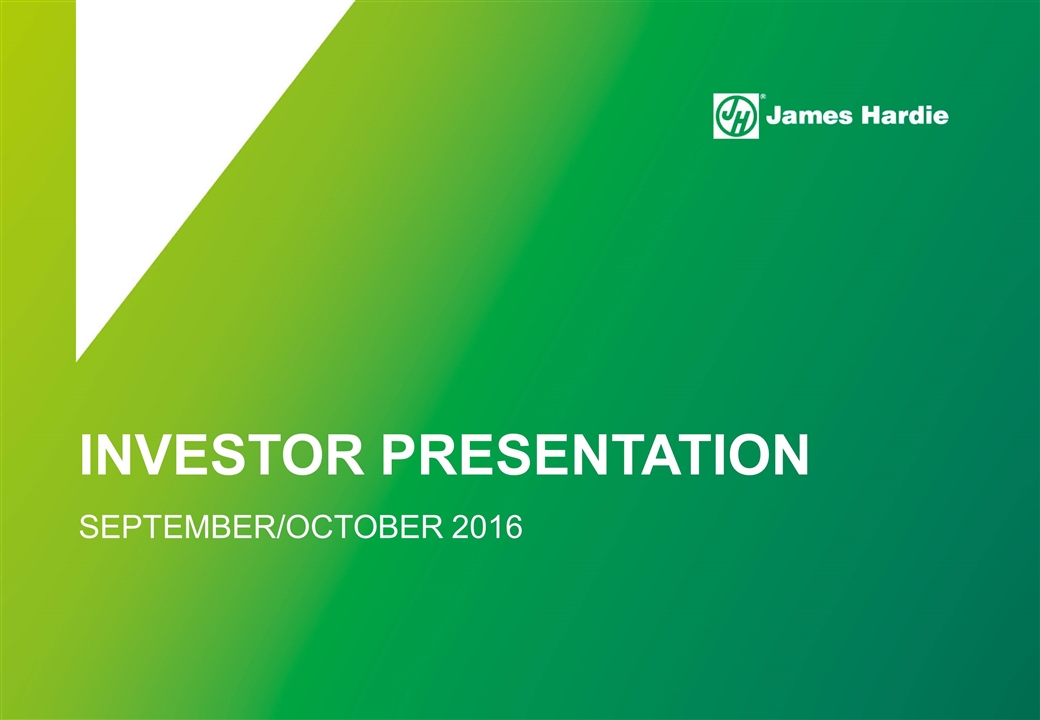
INVESTOR PRESENTATION SEPTEMBER/OCTOBER 2016